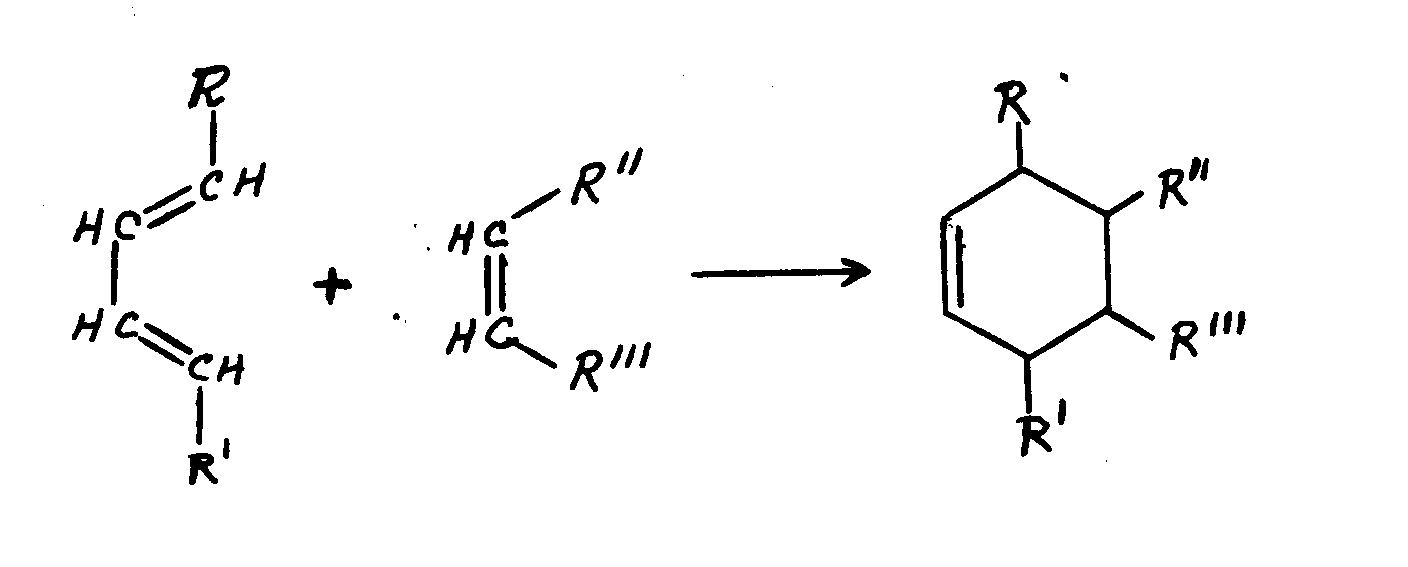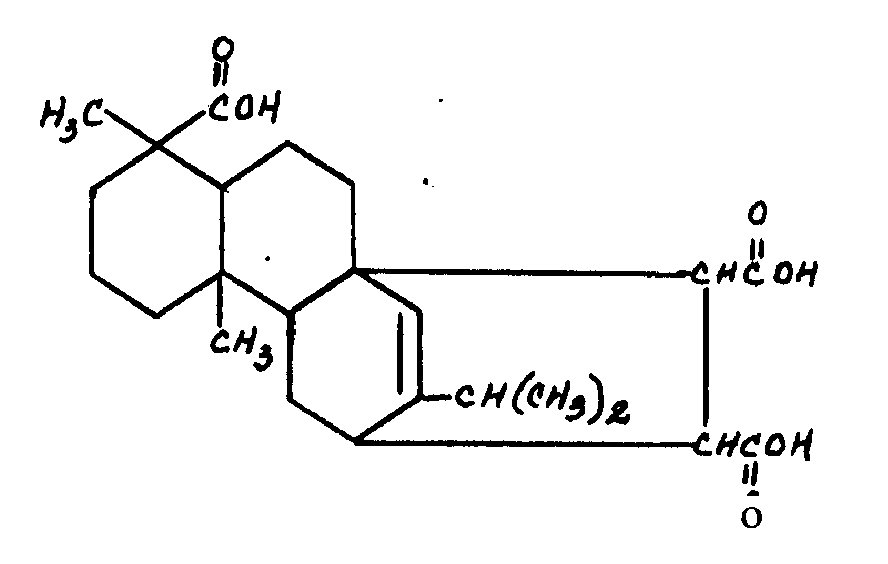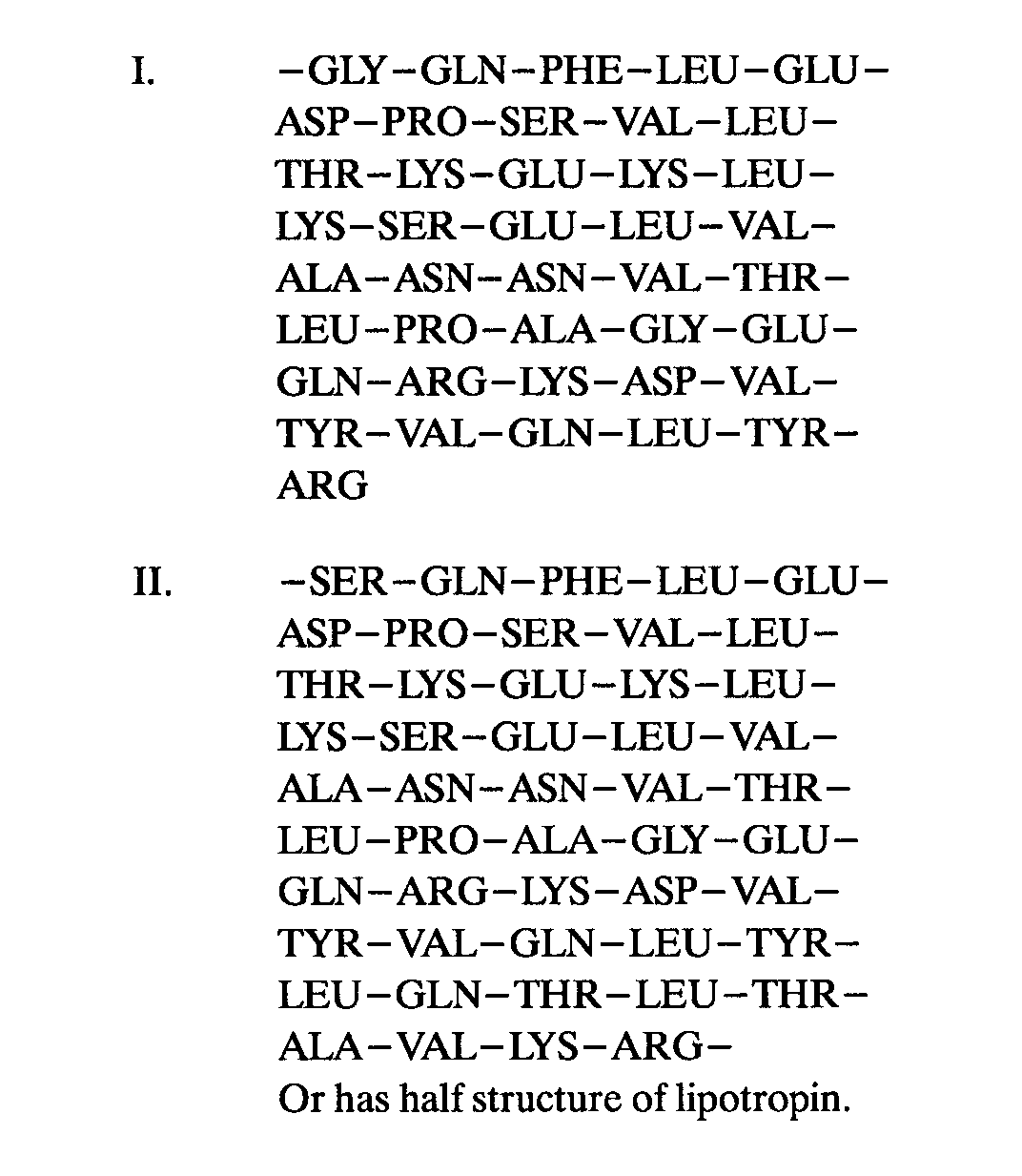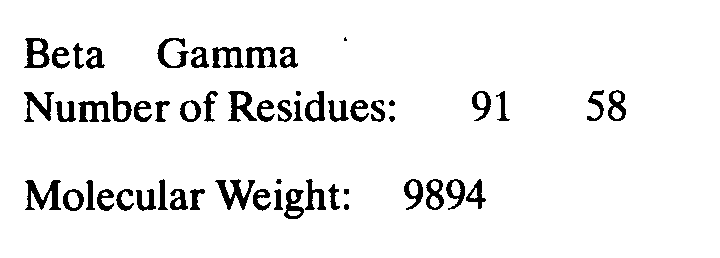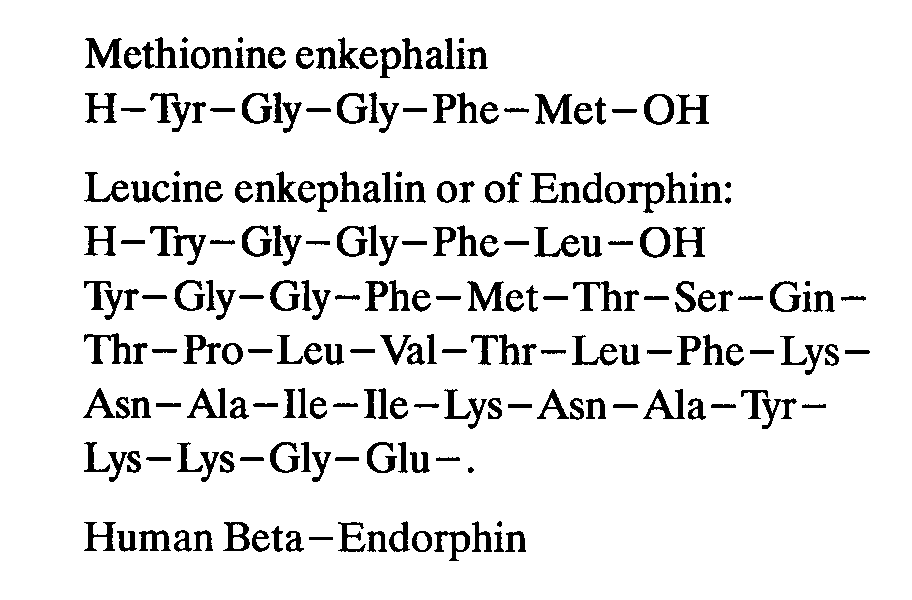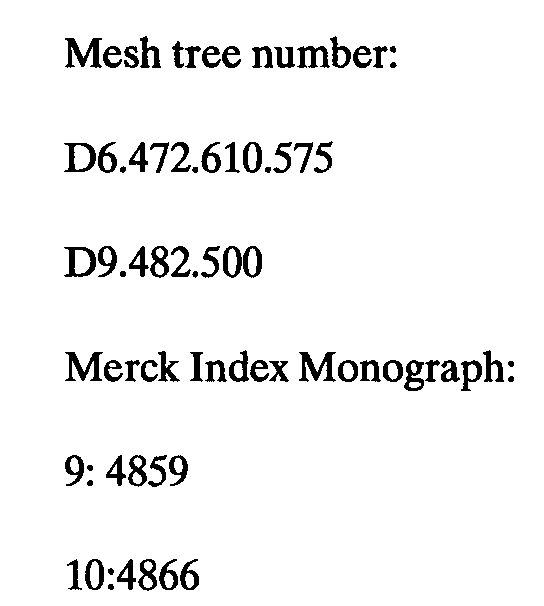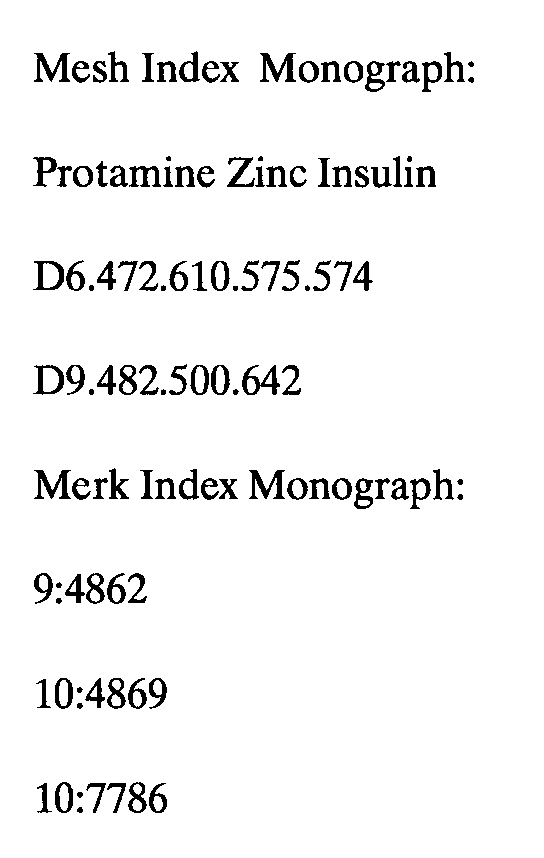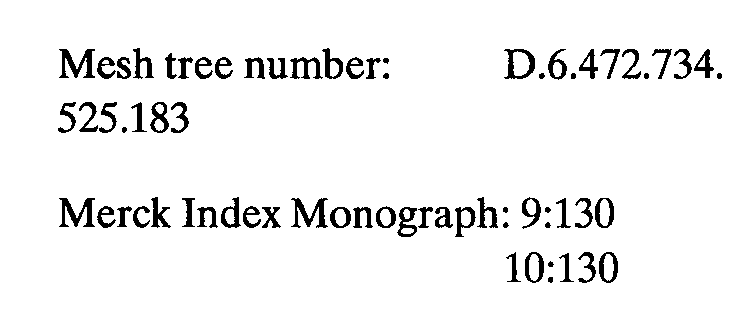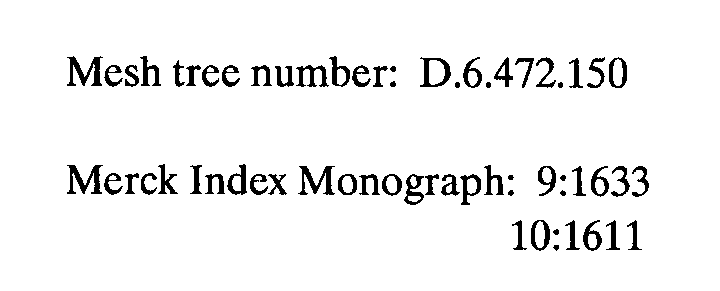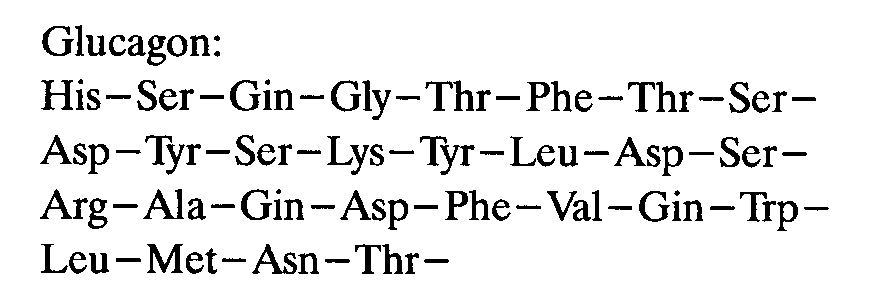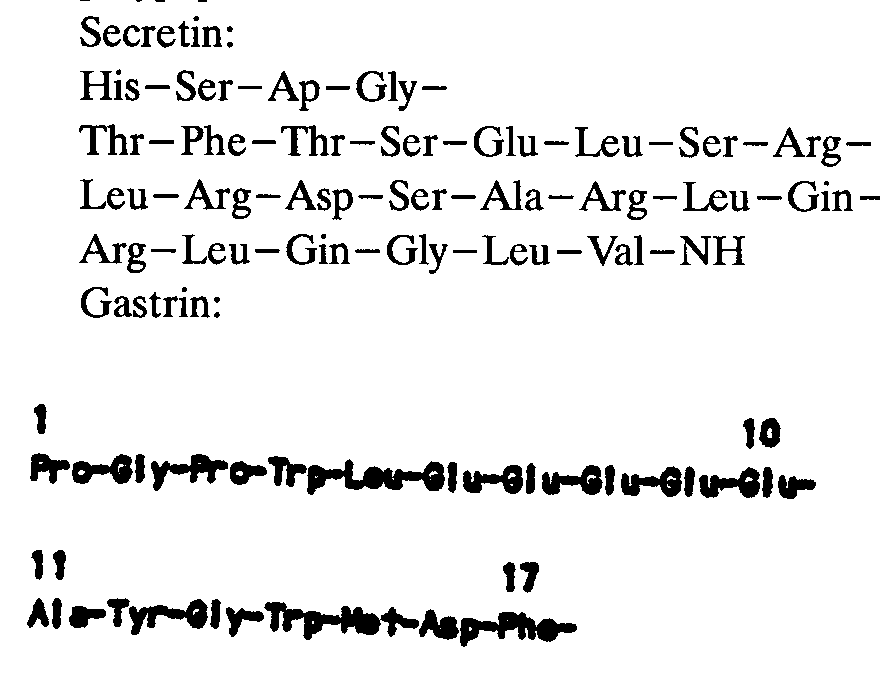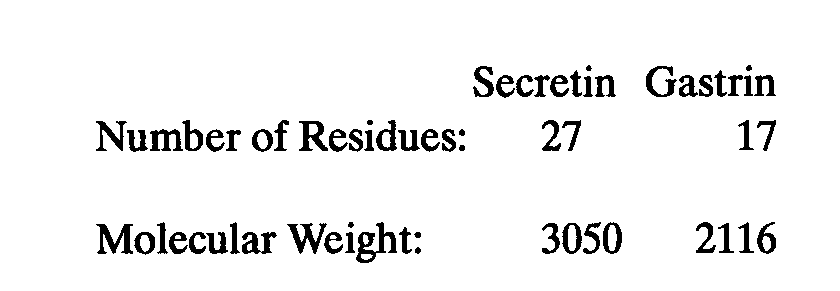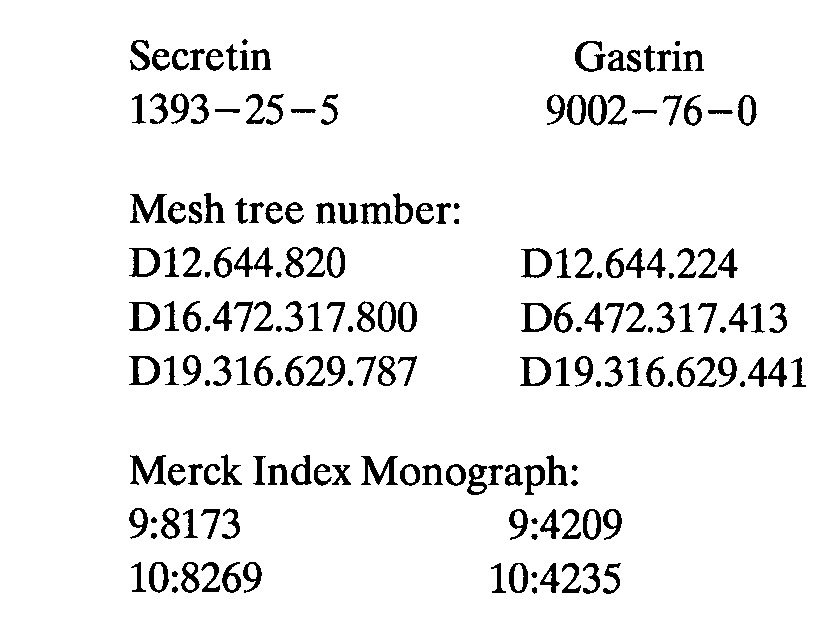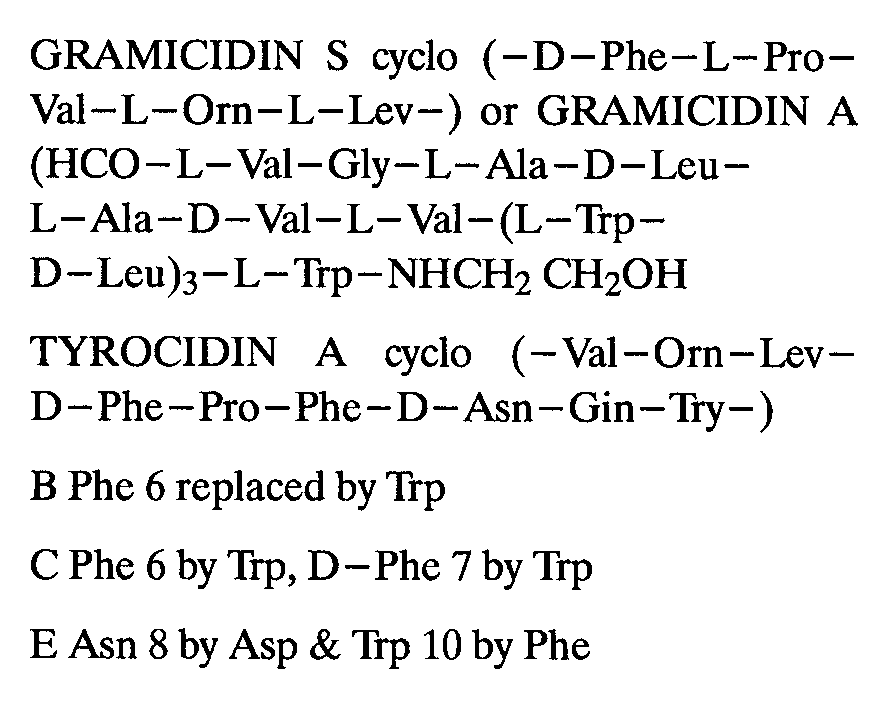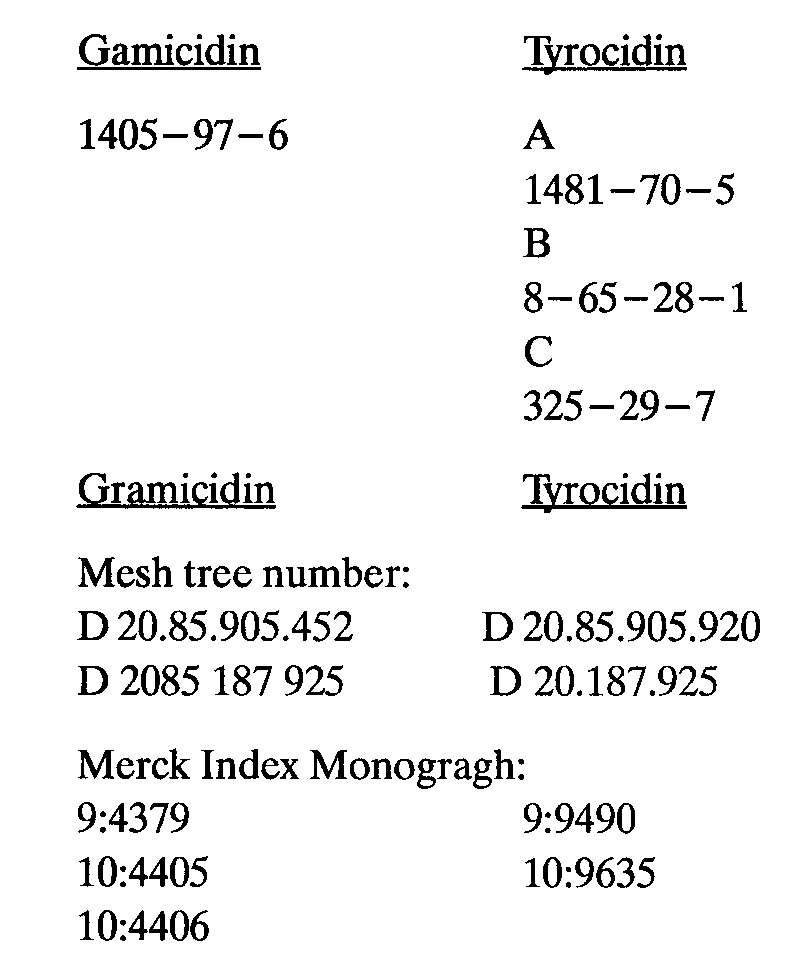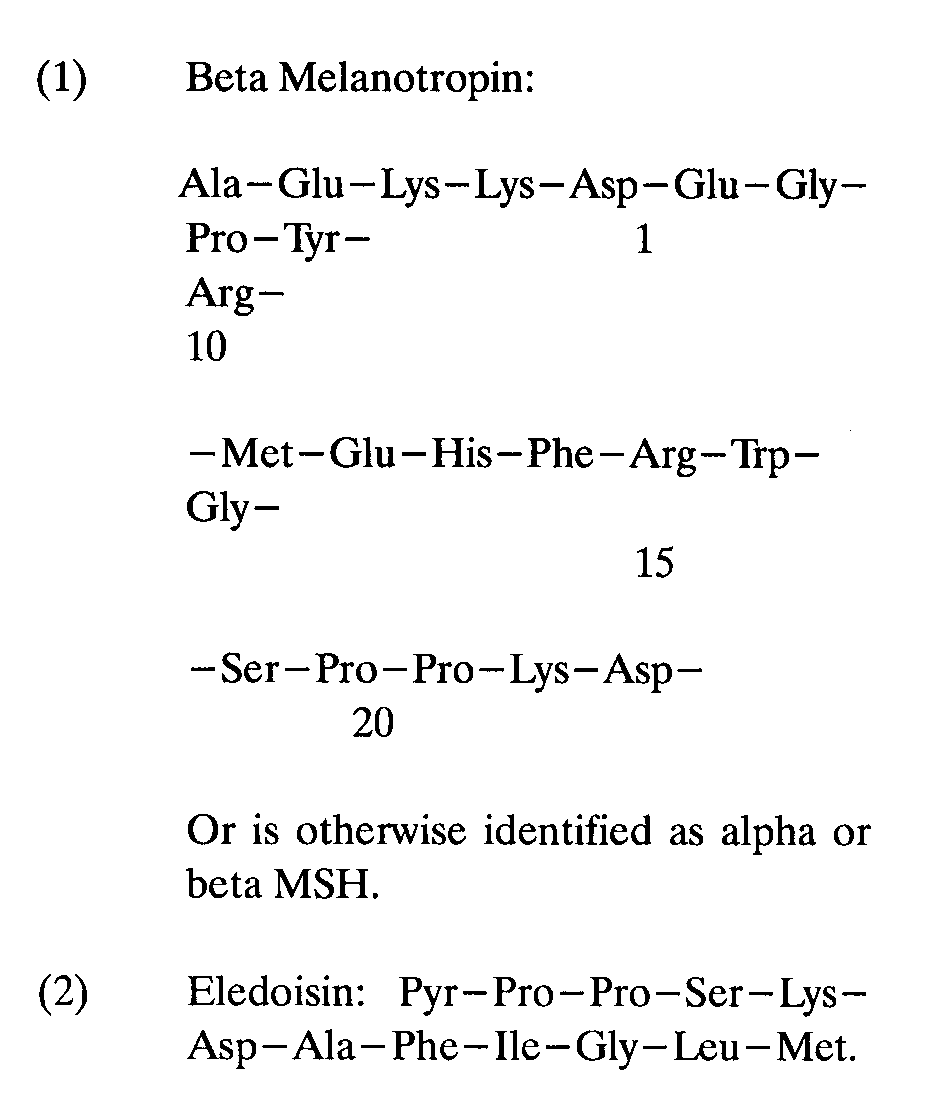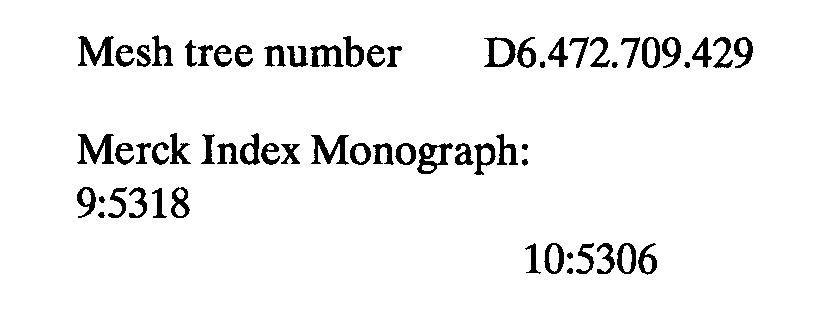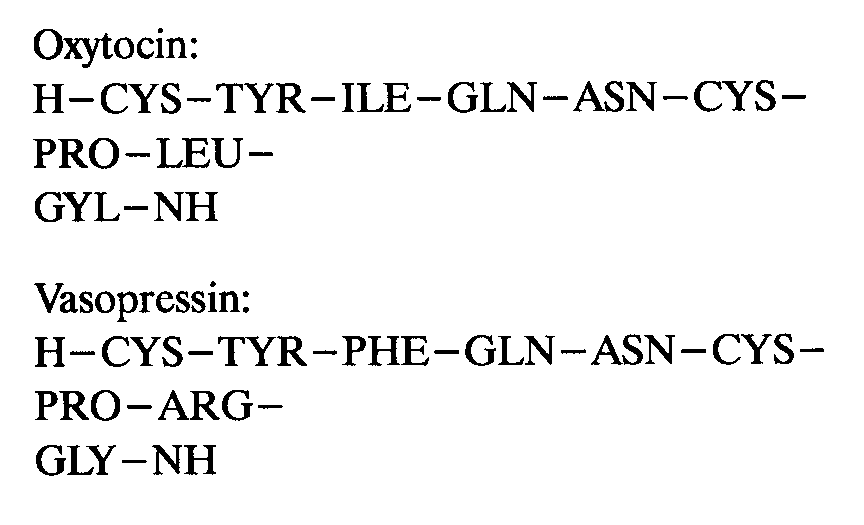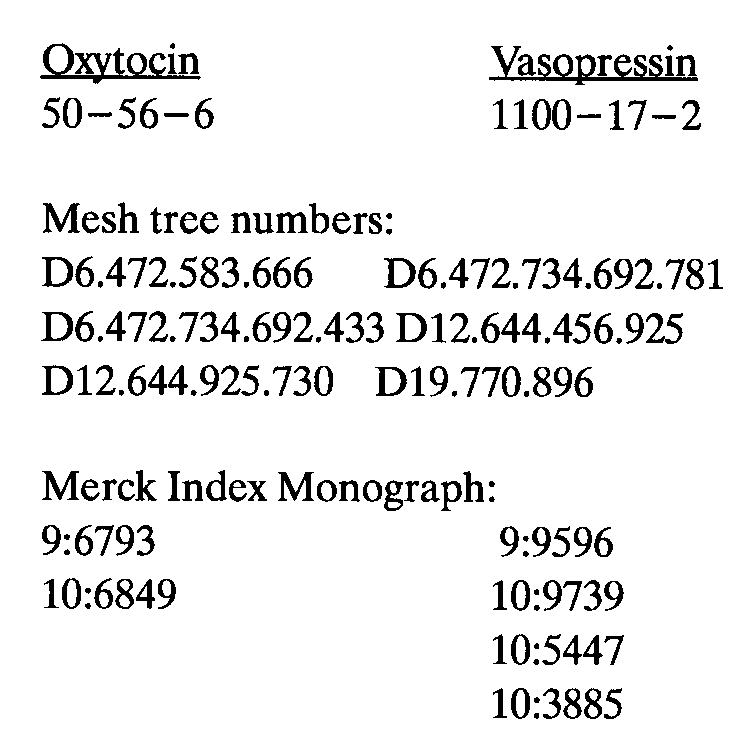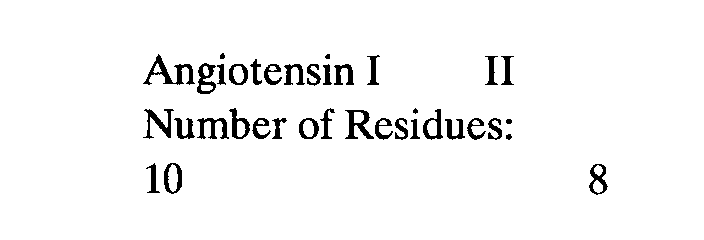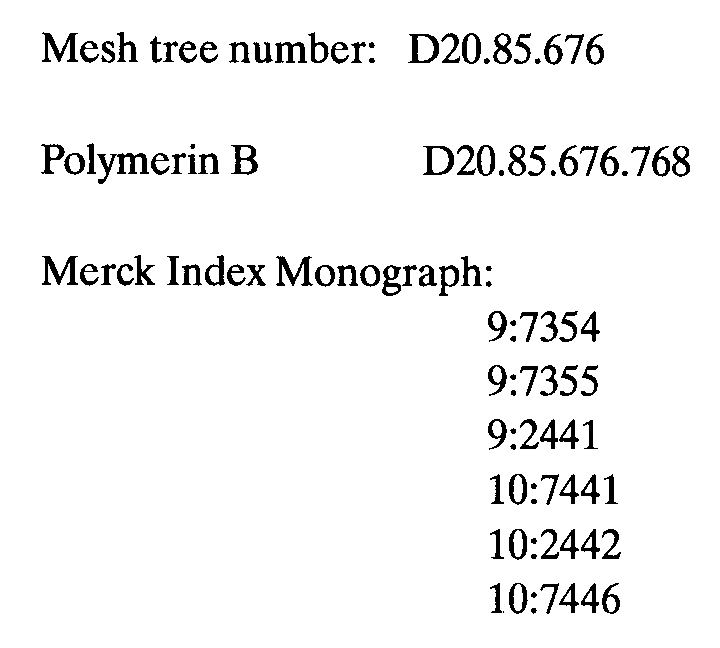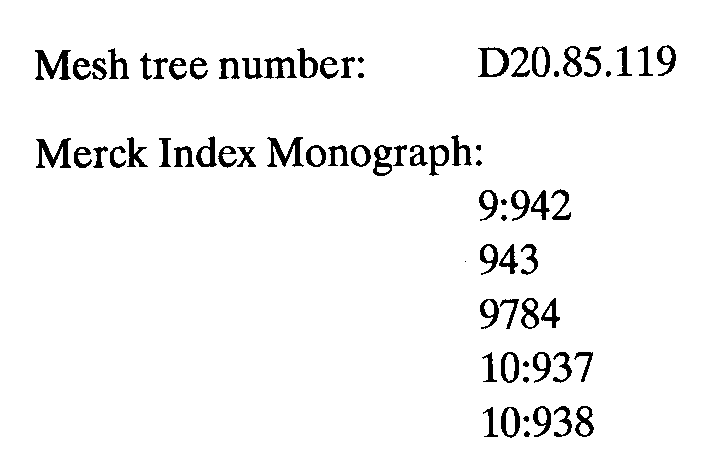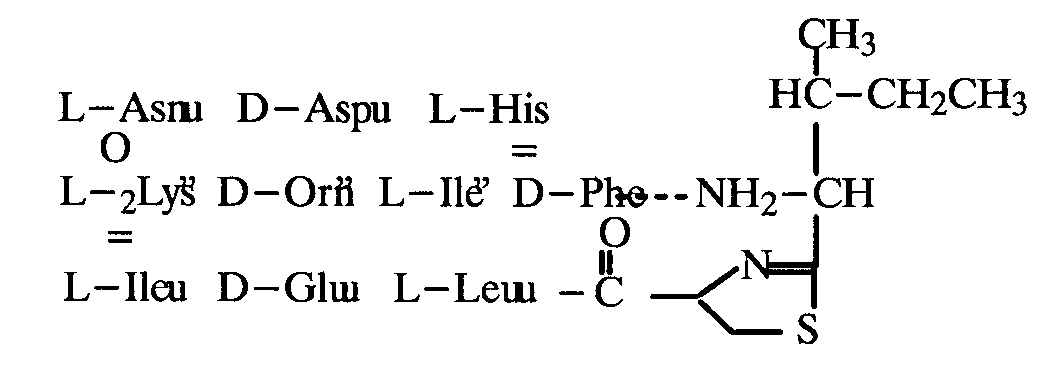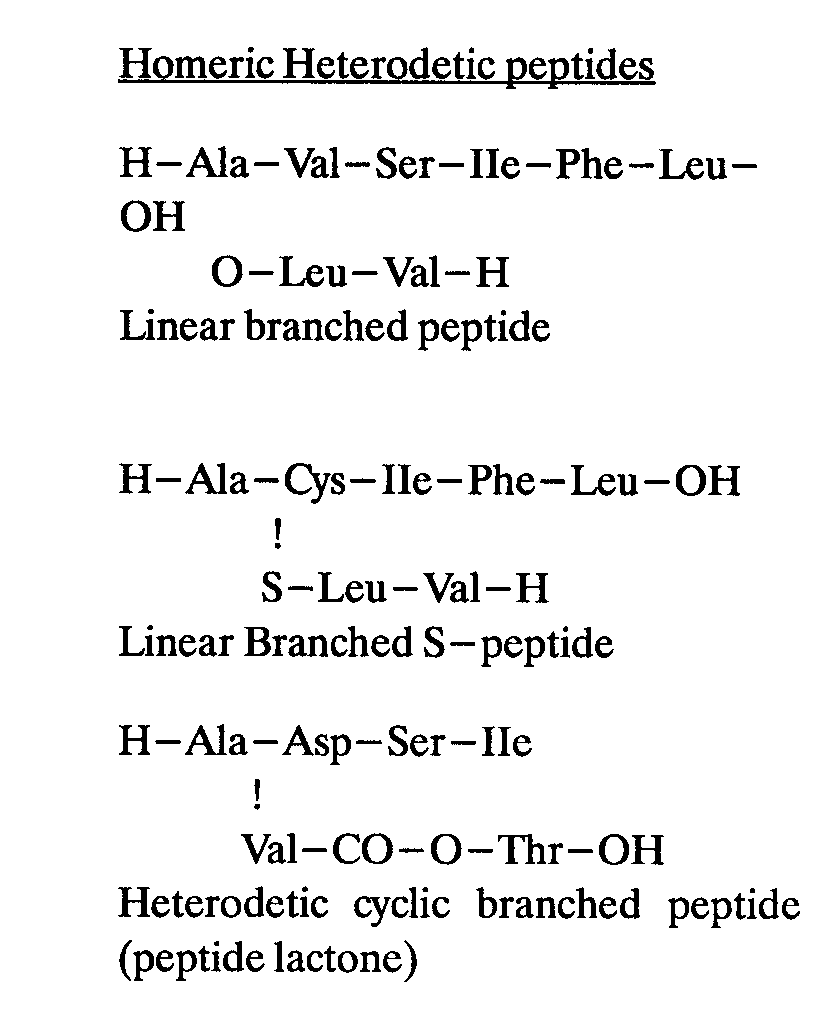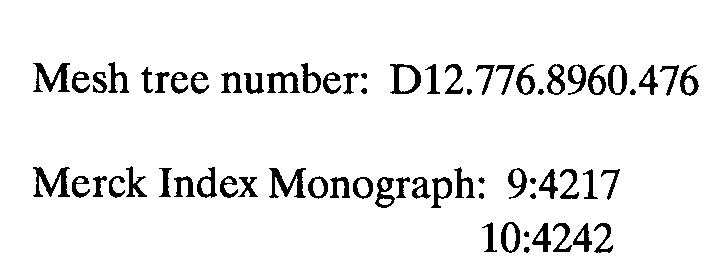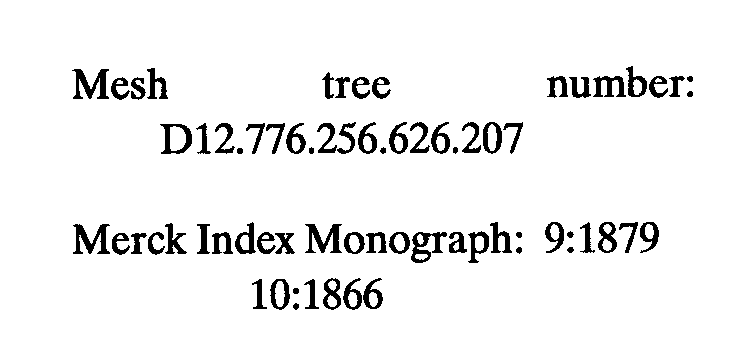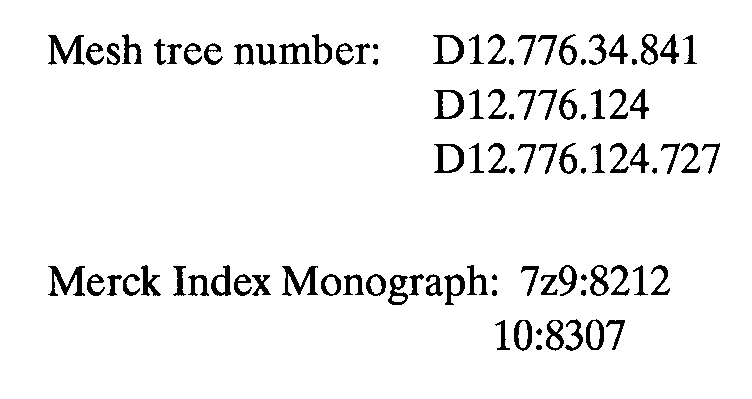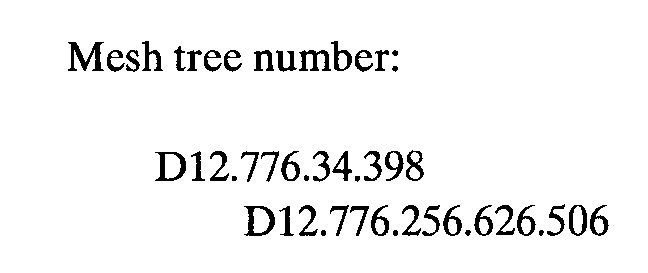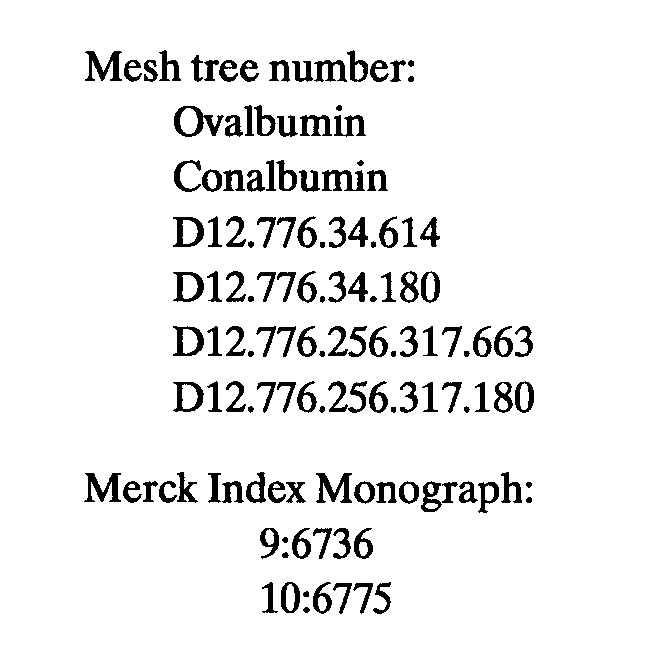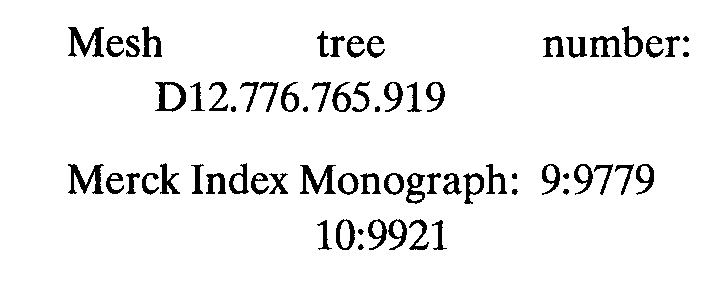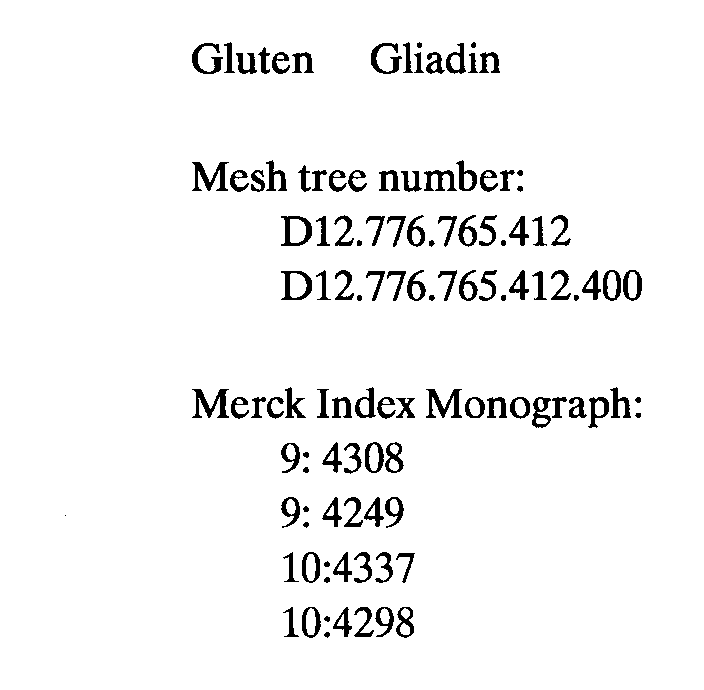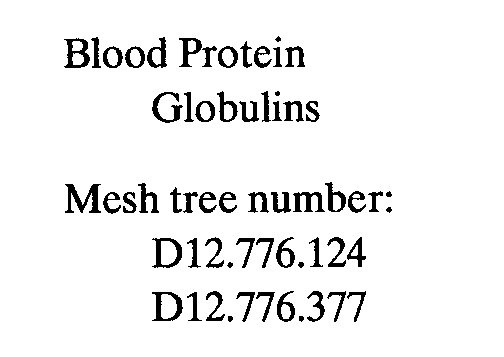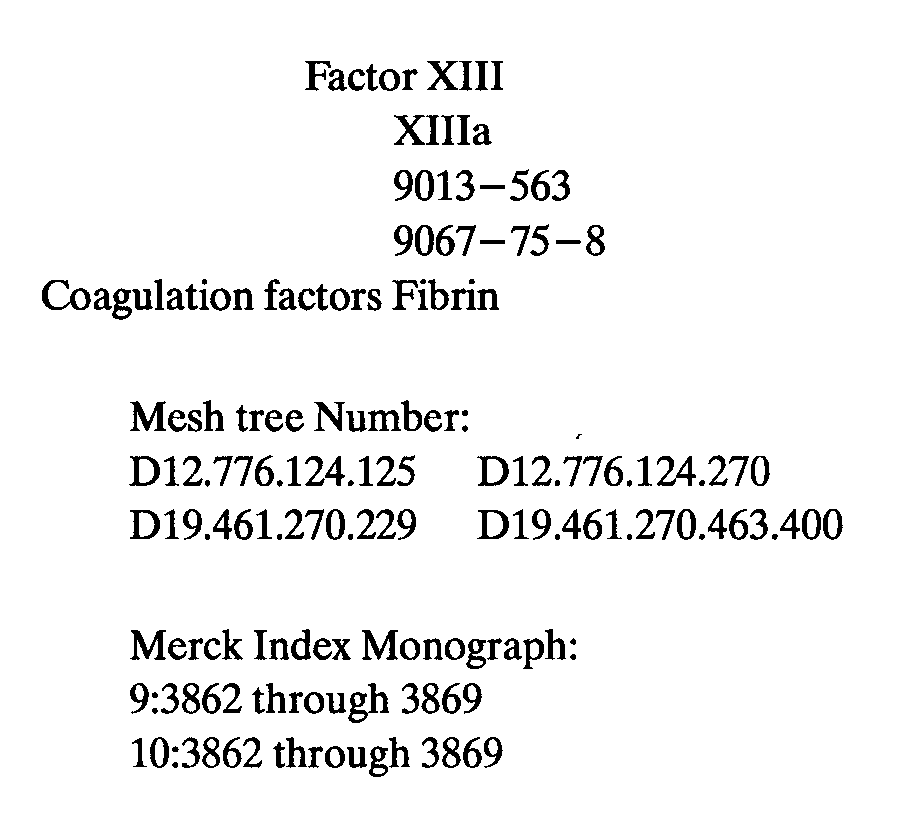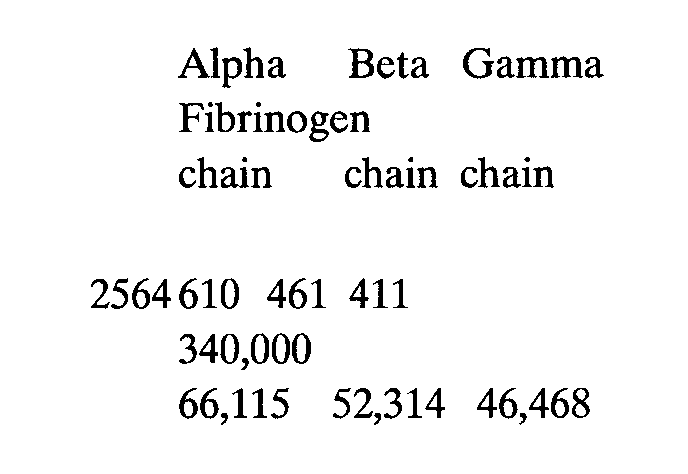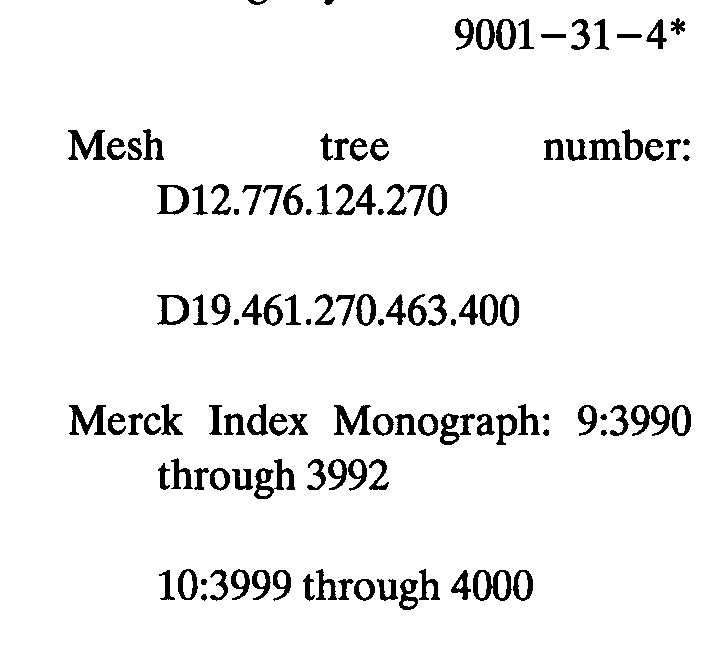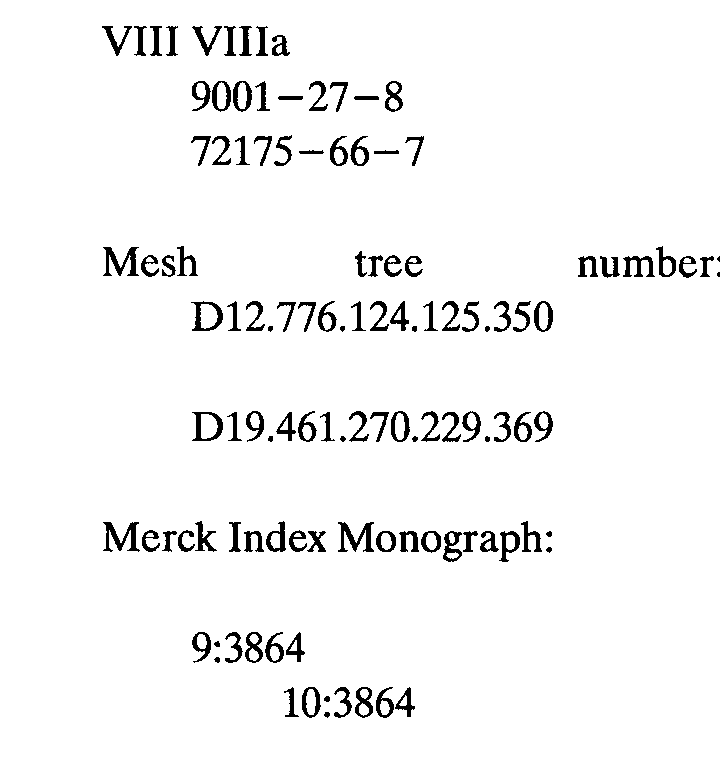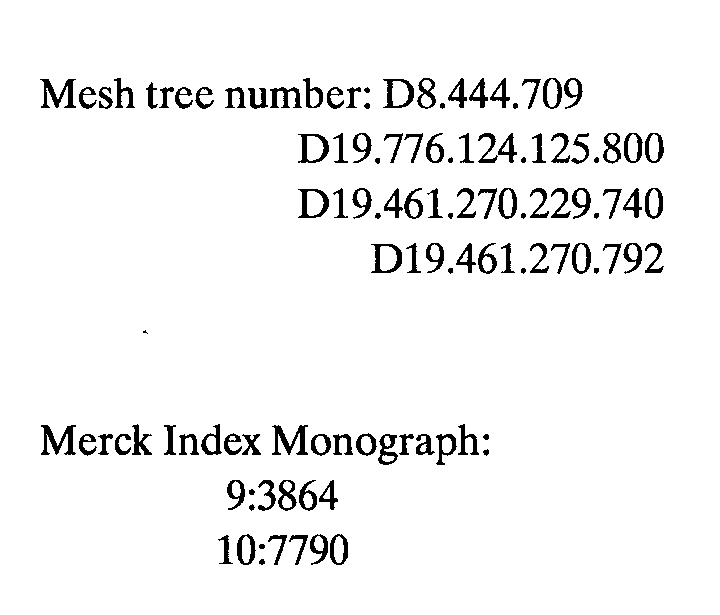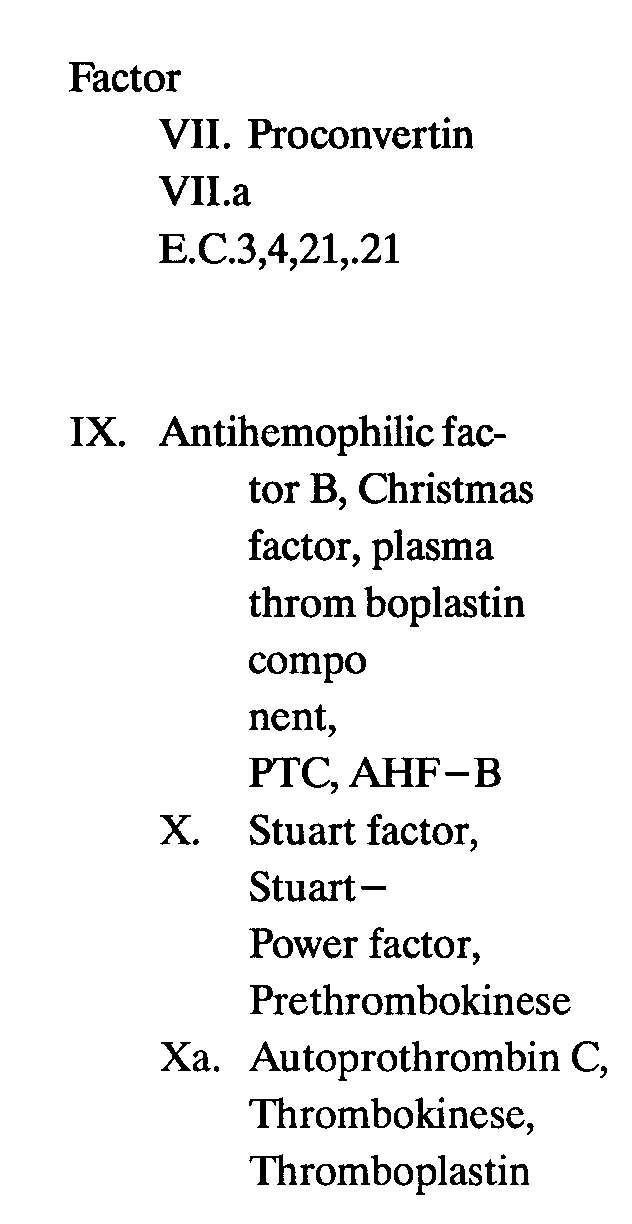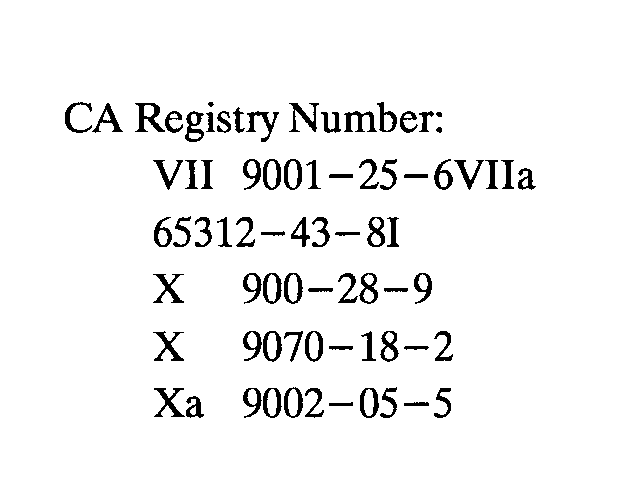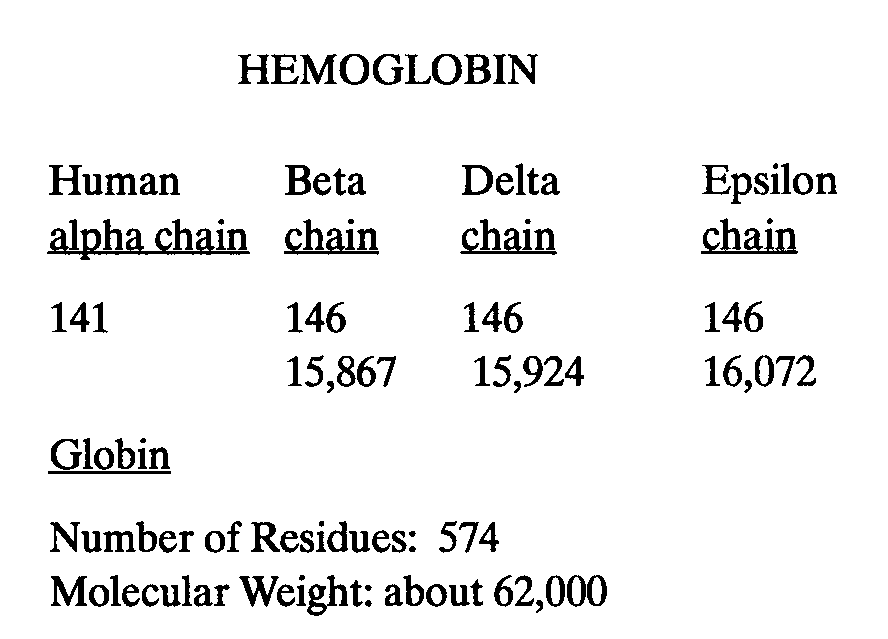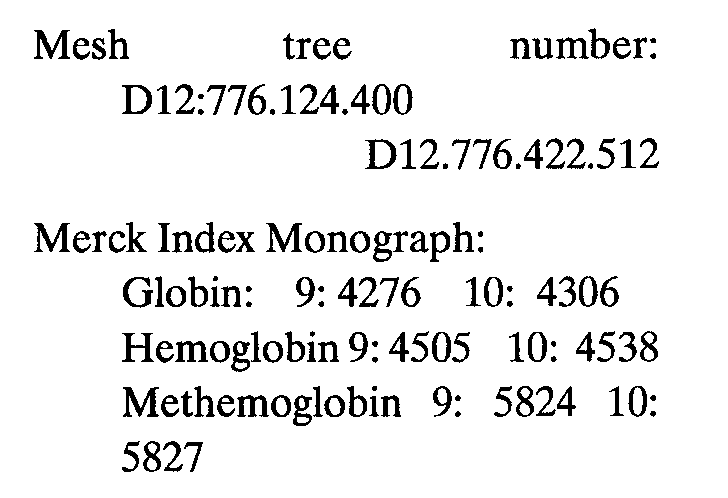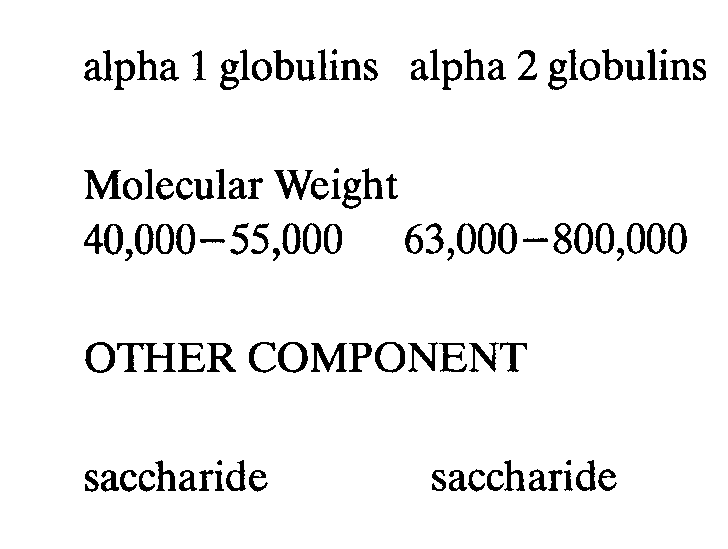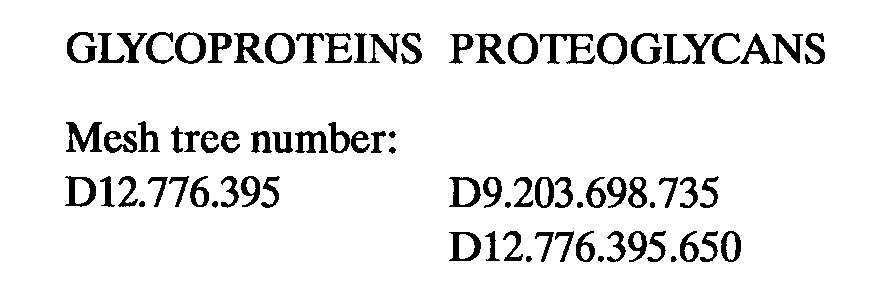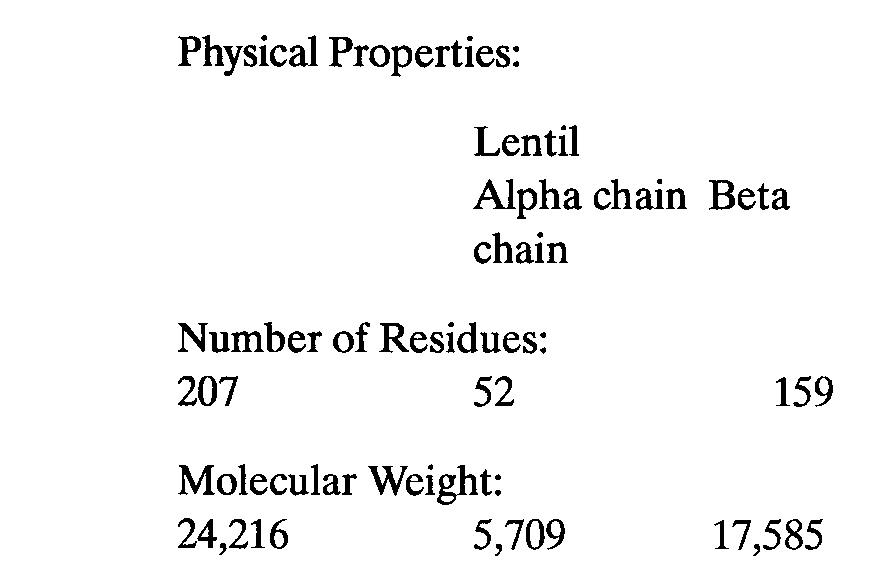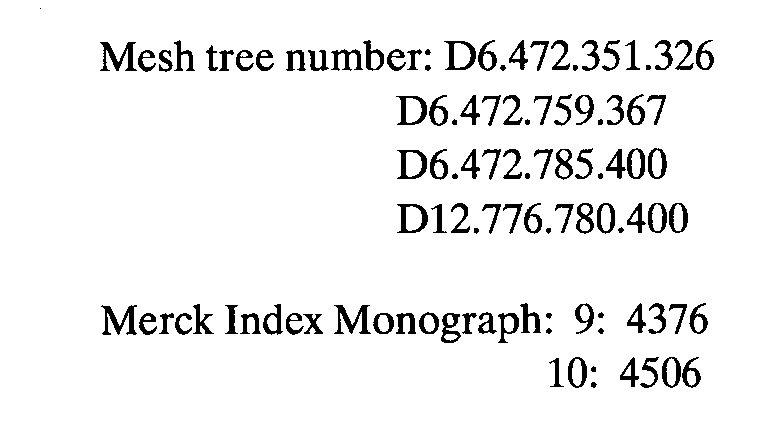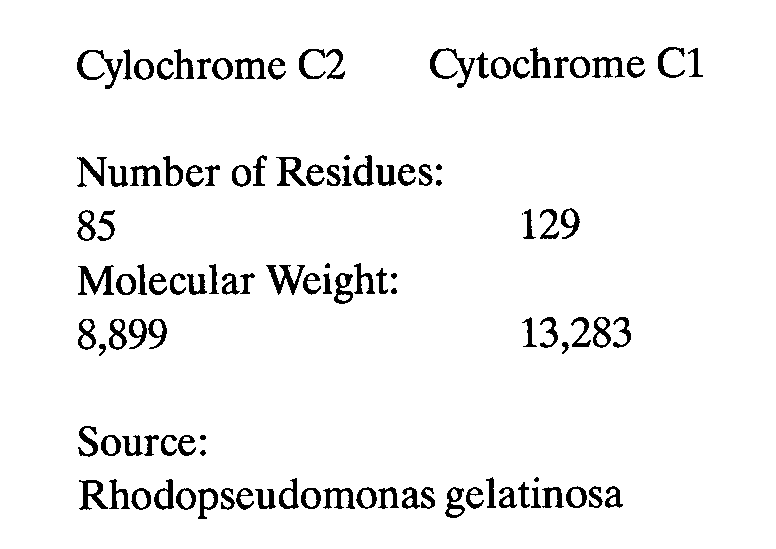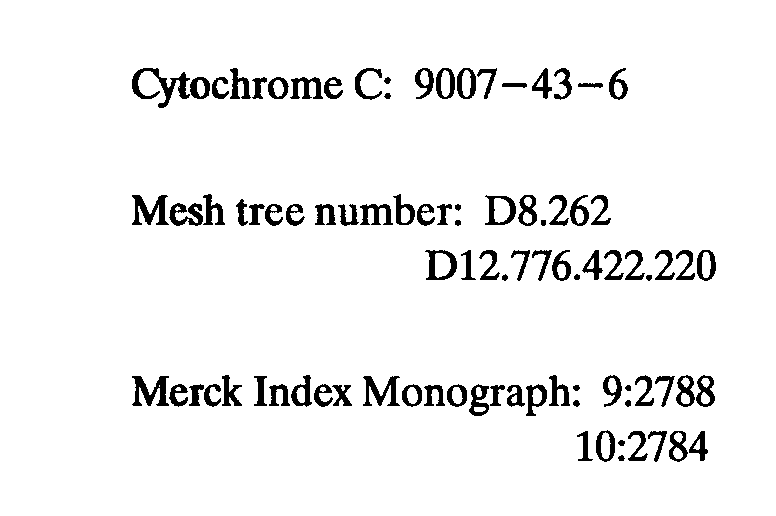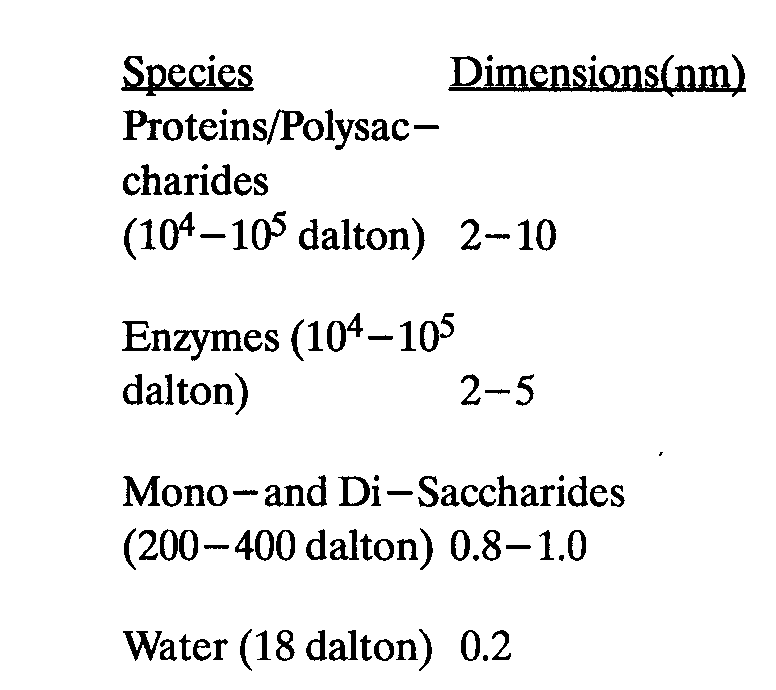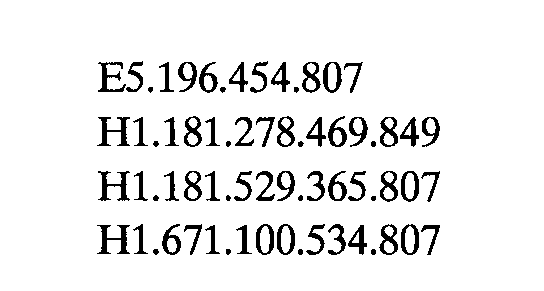![[Search a list of Patent Appplications for class 530]](../as.gif) CLASS 530, CLASS 530, | CHEMISTRY: NATURAL RESINS OR DERIVATIVES; PEPTIDES OR PROTEINS; LIGNINS OR REACTION PRODUCTS THEREOF |
| Click here for a printable version of this file | |
SUBCLASSES
![[List of Patents for class 530 subclass 200]](../ps.gif) 200 200 | NATURAL RESINS OR DERIVATIVES (E.G., WOOD OR PINE TAR; CATIVO RESIN DERIVATIVES, ETC.): | ||||||||||||||||||||||||||||||||
This subclass is indented under Class 260, subclass
1. Natural resin derivatives which are not pure compounds,
and processes of treating natural resins or derivatives.
SEE OR SEARCH THIS CLASS, SUBCLASS:
SEE OR SEARCH CLASS:
| |||||||||||||||||||||||||||||||||
![[List of Patents for class 530 subclass 201]](../ps.gif) 201 201 | Shellac containing starting material used in process, or product thereof (e.g., lac, sticklac, seedlac, flake shellac, bleached shellac, etc.): | ||
This subclass is indented under subclass 200. Processes wherein the starting material is shellac, or a
shellac-containing substance, or products of such processes.
| |||
![[List of Patents for class 530 subclass 202]](../ps.gif) 202 202 | Cut wood starting material used in process, or product thereof (e.g., using pine stumps, chips, bark, etc., as starting material): | ||||||
This subclass is indented under subclass 200. Processes wherein the starting material is cut wood, or
products of such processes.
SEE OR SEARCH THIS CLASS, SUBCLASS:
| |||||||
![[List of Patents for class 530 subclass 203]](../ps.gif) 203 203 | Plant sap or fossil starting material used in process, or product thereof (e.g., using copal, coal, amber, dammar, etc., as starting material): | ||
This subclass is indented under subclass 200. Processes wherein the starting material is plant sap or
a fossilized substance, or products of such processes.
| |||
![[List of Patents for class 530 subclass 204]](../ps.gif) 204 204 | Pine oleoresin starting material used in process, or product thereof (e.g., using gum turpentine, pine gum, pine resin, etc., as starting material): | ||||||
This subclass is indented under subclass 203. Processing wherein the starting material is pine oleoresin,
or products of such processes.
| |||||||
![[List of Patents for class 530 subclass 205]](../ps.gif) 205 205 | Recovery of tall oil or derivatives from papermaking waste, purification of tall oil, or separation of components of tall oil; or product thereof (e.g., separation of rosin, fatty acids, sterols, etc.; decolorizing, etc.): | ||||||||
This subclass is indented under subclass 200. Processes wherein: (1) tall oil or a derivative thereof
is recovered from papermaking waste; (2) one or more components
are separated from tall oil; (3) tall oil is purified; or products
of such processes.
| |||||||||
![[List of Patents for class 530 subclass 206]](../ps.gif) 206 206 | Organic sulfur or nitrogen containing material used in the process, or product thereof: |
| This subclass is indented under subclass 205. Processes wherein there is utilized an organic material containing sulfur or nitrogen, or products of such processes. | |
![[List of Patents for class 530 subclass 207]](../ps.gif) 207 207 | Esterification used in the process, or product thereof: |
| This subclass is indented under subclass 205. Processes which include an esterification step, or products of such processes. | |
![[List of Patents for class 530 subclass 208]](../ps.gif) 208 208 | Inorganic material used in the process, or product thereof (e.g., using sulfuric acid, boric acid, etc.): |
| This subclass is indented under subclass 205. Process wherein there is utilized an inorganic material, or products of such processes. | |
![[List of Patents for class 530 subclass 209]](../ps.gif) 209 209 | Phosphorus or heavy metal containing material, elemental hydrogen, sulfur dioxide, or carbon dioxide used in the process, or product thereof: |
| This subclass is indented under subclass 208. Processes wherein there is utilized a material containing phosphorus, heavy metal, elemental hydrogen, sulfur dioxide, or carbon dioxide; or products of such processes. | |
![[List of Patents for class 530 subclass 210]](../ps.gif) 210 210 | Rosin or derivative used as starting material in process, or product thereof (e.g., using gum rosin, wood rosin, solid tall oil rosin, etc.): | ||||||||||||
This subclass is indented under subclass 200. Processes wherein rosin or a derivative thereof is used
as starting material, or products of such processes.
SEE OR SEARCH CLASS:
| |||||||||||||
![[List of Patents for class 530 subclass 211]](../ps.gif) 211 211 | Polymerization or product thereof (e.g., dimer rosin, etc.): | ||||||||
This subclass is indented under subclass 210. Processes wherein rosin or a derivative thereof is polymerized,
or products of such processes.
SEE OR SEARCH CLASS:
| |||||||||
![[List of Patents for class 530 subclass 212]](../ps.gif) 212 212 | Chemical treatment or color modification of polymerized rosin or derivative, or product thereof (e.g., hydrogenation or esterification of polymerized rosin; removal of color bodies from polymerized rosin, etc.): |
| This subclass is indented under subclass 211. Processes wherein polymerized rosin or a derivative thereof undergoes further chemical treatment or color modification, or products of such processes. | |
![[List of Patents for class 530 subclass 213]](../ps.gif) 213 213 | Boron or phosphorus containing material used in the process, or product thereof: |
| This subclass is indented under subclass 210. Processes wherein there is utilized a material containing boron or phosphorus, or products of such processes. | |
![[List of Patents for class 530 subclass 214]](../ps.gif) 214 214 | Diels-Alder adducts (e.g., of maleic anhydride, fumaric acid, etc., with conjugated dienes, such as rosin acids, terpenes, etc.): | ||||
This subclass is indented under subclass 210. Products which include a six-membered ring formed by the
addition of an alkene or alkyne to the 1,4 - positions of a conjugated
diene.
| |||||
![[List of Patents for class 530 subclass 215]](../ps.gif) 215 215 | Esterification of rosin or derivative via carboxyl group, or product thereof: | ||
This subclass is indented under subclass 210. Processes wherein the carboxyl group of rosin or of a derivative
thereof is esterified, or products of such processes.
| |||
![[List of Patents for class 530 subclass 216]](../ps.gif) 216 216 | Chemical treatment or color modification of esterified rosin or derivative, or product thereof (e.g., partial saponification of rosin triglycerides; removal of color bodies from rosin esters, etc.): |
| This subclass is indented under subclass 215. Processes wherein esterified rosin or a derivative thereof undergoes further chemical treatment or color modification, or products of such processes. | |
![[List of Patents for class 530 subclass 217]](../ps.gif) 217 217 | Oxygen containing ring or halogen containing material used in the esterification, or product thereof (e.g., using alkylene oxides, polysaccharides, alkyl halides, etc.): |
| This subclass is indented under subclass 215. Processes wherein the esterification utilizes an oxygen ring containing compound or a halogen containing material, or products of such processes. | |
![[List of Patents for class 530 subclass 218]](../ps.gif) 218 218 | Polyhydroxy material used in the esterification, or product thereof (e.g., forming ester gum, etc.): |
| This subclass is indented under subclass 215. Processes wherein the esterification utilizes a polyhydroxy containing material, or products of such processes. | |
![[List of Patents for class 530 subclass 219]](../ps.gif) 219 219 | Sulfur, selenium, or tellurium containing material used in the process, or product thereof (e.g., disproportionation of rosin, etc.): | ||
This subclass is indented under subclass 210. Processes wherein there is utilized a material containing
sulfur, selenium or tellurium, or products of such processes.
| |||
![[List of Patents for class 530 subclass 220]](../ps.gif) 220 220 | The sulfur, selenium, or tellurium containing material is inorganic: |
| This subclass is indented under subclass 219. Processes wherein the material containing sulfur, selenium or tellurium is inorganic. | |
![[List of Patents for class 530 subclass 221]](../ps.gif) 221 221 | Nitrogen containing material used in the process, or product thereof: |
| This subclass is indented under subclass 210. Processes wherein there is utilized a nitrogen containing material, or products of such processes. | |
![[List of Patents for class 530 subclass 222]](../ps.gif) 222 222 | The nitrogen containing material is inorganic: |
| This subclass is indented under subclass 221. Processes wherein the material containing nitrogen is inorganic. | |
![[List of Patents for class 530 subclass 223]](../ps.gif) 223 223 | Hydrogenation or product thereof (e.g., forming dihydro rosin acids; rosinyl alcohol or derivatives; etc.): |
| This subclass is indented under subclass 210. Processes wherein rosin or a derivative thereof is reacted with hydrogen, or products of such processes. | |
![[List of Patents for class 530 subclass 224]](../ps.gif) 224 224 | Metal containing material used to form salts of rosin acids, or product thereof: | ||||||||
This subclass is indented under subclass 210. Processes wherein salts of rosin acids are formed using
a metal containing material, or products of such processes.
SEE OR SEARCH CLASS:
| |||||||||
![[List of Patents for class 530 subclass 225]](../ps.gif) 225 225 | Alkali metal containing material (i.e., Li, Na, K, Rb or Cs): | ||||
| This subclass is indented under subclass 224. Processes wherein the metal is an alkali metal.
SEE OR SEARCH CLASS:
| |||||
![[List of Patents for class 530 subclass 226]](../ps.gif) 226 226 | Heat treatment of rosin or derivative in the absence of nonrosin organic reactants, or product thereof (e.g., forming rosin oil; disproportionated, dehydrogenated, or isomerized rosin; etc.): | ||||
This subclass is indented under subclass 210. Processes wherein rosin or a derivative thereof is subjected
to heat treatment in the absence of any additional nonrosin organic
reactant, or products of such processes.
SEE OR SEARCH THIS CLASS, SUBCLASS:
| |||||
![[List of Patents for class 530 subclass 227]](../ps.gif) 227 227 | Metal, halogen, or silicon containing material used in the process, or product thereof (e.g., using clay, zeolites, etc.): |
| This subclass is indented under subclass 226. Processes wherein a metal, halogen or silicon containing material is utilized, or products of such processes. | |
![[List of Patents for class 530 subclass 228]](../ps.gif) 228 228 | Purification process or product thereof: |
| This subclass is indented under subclass 210. Processes for purification of rosin or its derivatives, or products of such processes. | |
![[List of Patents for class 530 subclass 229]](../ps.gif) 229 229 | Immiscible solvents used in the process, or product thereof: |
| This subclass is indented under subclass 228. Processes which utilize immiscible solvents, or products of such processes. | |
![[List of Patents for class 530 subclass 230]](../ps.gif) 230 230 | Tall oil or derivative used as starting material in process, or product thereof (e.g., metal salts of tall oil fatty acids; tall oil pitch, etc.) dehydrogenated, or isomerized rosin; etc.): | ||||||
This subclass is indented under subclass 200. Processes wherein the starting material used is tall oil
or a derivative thereof, or products of such processes.
| |||||||
![[List of Patents for class 530 subclass 231]](../ps.gif) 231 231 | Nitrogen containing material used in the process, or product thereof: |
| This subclass is indented under subclass 230. Processes which utilize a nitrogen containing material, or products of such processes. | |
![[List of Patents for class 530 subclass 232]](../ps.gif) 232 232 | Esterification of tall oil acids, or product thereof: |
| This subclass is indented under subclass 230. Processes wherein the acids present in tall oil are esterified, or products of such processes. | |
![[List of Patents for class 530 subclass 233]](../ps.gif) 233 233 | Sulfur, boron, phosphorus, or iodine containing material used in the process, or product thereof: |
| This subclass is indented under subclass 230. Processes wherein a material containing sulfur, boron phosphorus, or iodine is utilized, or products of such processes. | |
![[List of Patents for class 530 subclass 300]](../ps.gif) 300 300 | PEPTIDES OF 3 TO 100 AMINO ACID RESIDUES: | ||||||||||||||||||||||||||||||||||||||||||||||||||||||||||||||||||||||||||||||||||||||||||||||||||||||||||||||||||||||||||||||||||||||||||||||||||||||||||||||||||||||||||||||||||||||||||||||||||||||||||||||
This subclass is indented under Class 260, subclass
1. Compounds consisting of three or more amino acids joined
covalently by peptide bonds.
SEE OR SEARCH CLASS:
| |||||||||||||||||||||||||||||||||||||||||||||||||||||||||||||||||||||||||||||||||||||||||||||||||||||||||||||||||||||||||||||||||||||||||||||||||||||||||||||||||||||||||||||||||||||||||||||||||||||||||||||||
![[List of Patents for class 530 subclass 301]](../ps.gif) 301 301 | Thymopoietin or Lipotropin; related peptides: | ||||||||||||||||
| This subclass is indented under subclass 300. Peptides containing at least half the amino acid residues
in sequence of the polypeptide with the structure of Thymopoietin.
SEE OR SEARCH CLASS:
| |||||||||||||||||
![[List of Patents for class 530 subclass 302]](../ps.gif) 302 302 | Endorphins and Enkephalins; related peptides: | ||||||||||
| This subclass is indented under subclass 300. Peptides containing at least half the amino acid residues
in sequence of the polypeptide with the structure:
SEE OR SEARCH CLASS:
| |||||||||||
![[List of Patents for class 530 subclass 303]](../ps.gif) 303 303 | Insulin; related peptides: | ||||||
This subclass is indented under subclass 300. Peptides containing at least half the amino acid residues
in sequence of the polypeptide with the structure of insulin.
| |||||||
![[List of Patents for class 530 subclass 304]](../ps.gif) 304 304 | Metal complexes, e.g., Zn-insulin, etc: | ||||||
This subclass is indented under subclass 303. Peptides in which the peptide is a complex of insulin and
a metal.
| |||||||
![[List of Patents for class 530 subclass 305]](../ps.gif) 305 305 | Isolation or purification: | ||||
This subclass is indented under subclass 303. Subject matter, in which preexisting insulin is isolated
or separated.
| |||||
![[List of Patents for class 530 subclass 306]](../ps.gif) 306 306 | Corticotropins (ATCH); related peptides: | ||||||||||
| This subclass is indented under subclass 303. Peptides containing at least half the amino acid residues
in sequence of the polypeptide with the structure:
SEE OR SEARCH CLASS:
| |||||||||||
![[List of Patents for class 530 subclass 307]](../ps.gif) 307 307 | Calcitonin; related peptides: | ||||||||||
| This subclass is indented under subclass 300. Peptides containing at least half the amino acid residues
in sequence of the polypeptide with the structure:
SEE OR SEARCH CLASS:
| |||||||||||
![[List of Patents for class 530 subclass 308]](../ps.gif) 308 308 | Glucagon; related peptides: | ||||||||
| This subclass is indented under subclass 300. Peptides containing at least half the amino acid residues
in sequence of the polypeptide with the structure.
| |||||||||
![[List of Patents for class 530 subclass 309]](../ps.gif) 309 309 | Secretin or gastrin; related peptides: | ||||||||||
| This subclass is indented under subclass 300. Peptides containing at least half the amino acid residues
in sequence of the polypeptide with the structure:
| |||||||||||
![[List of Patents for class 530 subclass 310]](../ps.gif) 310 310 | Gramicidin or tyrocidin; related peptides: | ||||
| This subclass is indented under subclass 300. Peptides containing at least half the amino residues in
sequence of the polypeptide with the structure:
| |||||
![[List of Patents for class 530 subclass 311]](../ps.gif) 311 311 | Somatostatin (SRIF); related peptides: | ||||||||||
| This subclass is indented under subclass 300. Peptides containing at least half the amino acid residues
in sequence of the polypeptide with the structure:
SEE OR SEARCH CLASS:
| |||||||||||
![[List of Patents for class 530 subclass 312]](../ps.gif) 312 312 | Melanotropin (MSH) or eledoisin; related peptides: | ||||||||||
| Peptides under subclass 300 containing at least half the
amino acid residues in sequence of the polypeptide with the structure:
| |||||||||||
![[List of Patents for class 530 subclass 313]](../ps.gif) 313 313 | Lutenizing hormone-releasing factor (LRF); related peptides: | ||||||||||
| This subclass is indented under subclass 300. Peptides containing at least half the amino acid residues
in sequence of the polypeptide with the structure:
SEE OR SEARCH CLASS:
| |||||||||||
![[List of Patents for class 530 subclass 314]](../ps.gif) 314 314 | Bradykinin; kallidin; related peptides: | ||||||||
| This subclass is indented under subclass 300. Peptides containing at least half the amino acid residues
in sequence of the polypeptide with the structure:
| |||||||||
![[List of Patents for class 530 subclass 315]](../ps.gif) 315 315 | Oxytocin; vasopressin; related peptides: | ||||||||||
| This subclass is indented under subclass 300. Peptides containing at least half the amino acid residues
in sequence of the polypeptide with the structure:
SEE OR SEARCH CLASS:
| |||||||||||
![[List of Patents for class 530 subclass 316]](../ps.gif) 316 316 | Angiotensin; related peptides: | ||||||||||
| This subclass is indented under subclass 300. Peptides containing at least half the amino acid residues
in sequence of the polypeptide with the structure:
Angiotensin I
Angiotensin II
SEE OR SEARCH CLASS:
| |||||||||||
![[List of Patents for class 530 subclass 317]](../ps.gif) 317 317 | Cyclic peptides: | ||||||||||
Peptides under subclass 300 containing at least one ring
fused only through peptide bonds.
SEE OR SEARCH CLASS:
| |||||||||||
![[List of Patents for class 530 subclass 318]](../ps.gif) 318 318 | The cyclisation occurring through 4-amino radical of 2,4-diamino-butanoic acid: | ||
This subclass is indented under subclass 317. Peptides containing at least one diaminobutanoic acid residue
in the peptide cycle.
| |||
![[List of Patents for class 530 subclass 319]](../ps.gif) 319 319 | Polymyxin; related peptides: | ||||||
This subclass is indented under subclass 318. Peptides containing at least half the amino acid residues
of the polypeptide produced by Bacillus polymyxa and possessing
antibiotic activity against Gram-negative bacteria.
| |||||||
![[List of Patents for class 530 subclass 320]](../ps.gif) 320 320 | Bacitracin; related peptides: | ||||||
This subclass is indented under subclass 317. Peptides containing at least half the amino acid sequence
of Bacitracin.
| |||||||
![[List of Patents for class 530 subclass 321]](../ps.gif) 321 321 | Containing only normal peptide links in the ring, i.e., homodetic cyclic peptides: |
| This subclass is indented under subclass 317. Cyclic peptides containing at least one ring formed by peptide bonds through only the alpha amino group of an amino acid. | |
![[List of Patents for class 530 subclass 322]](../ps.gif) 322 322 | Peptides containing saccharide radicals, e.g., bieomycins, etc.: | ||||
This subclass is indented under subclass 300. Peptides containing at least one saccharide radical.
| |||||
![[List of Patents for class 530 subclass 323]](../ps.gif) 323 323 | Peptides with at least one nonpeptide bond other than a disulfide bond joining two or more sequences of amino acid residues, e.g., homomeric heterodectic peptide of other than cyclic disulfide, depsipeptides, etc.: | ||||||
This subclass is indented under subclass 300. Peptides in which a peptide chain contains an interchain
nonpeptide moiety.
SEE OR SEARCH CLASS:
| |||||||
![[List of Patents for class 530 subclass 324]](../ps.gif) 324 324 | 25 or more amino acid residues in defined sequence: | ||||
This subclass is indented under subclass 300. Compounds comprising from 25 or more amino acid residues
of defined primary structure.
| |||||
![[List of Patents for class 530 subclass 325]](../ps.gif) 325 325 | 24 amino acid residues in defined sequence: | ||||
This subclass is indented under subclass 300. Compounds comprising 24 amino acid residues of defined primary
structures.
| |||||
![[List of Patents for class 530 subclass 326]](../ps.gif) 326 326 | 15 to 23 amino acid residues in defined sequence: | ||||
This subclass is indented under subclass 300. Compounds comprising from 15 to 23 amino acid residues of
defined primary structure.
| |||||
![[List of Patents for class 530 subclass 327]](../ps.gif) 327 327 | 11 to 14 amino acid residues in defined sequence: | ||||
This subclass is indented under subclass 300. Compounds comprising from 11 to 14 amino acid residues of
defined primary structure.
| |||||
![[List of Patents for class 530 subclass 328]](../ps.gif) 328 328 | 8 to 10 amino acid residues in defined sequence: | ||||
This subclass is indented under subclass 300. Compounds comprising from 8 to 10 amino acid residues of
defined primary structure.
| |||||
![[List of Patents for class 530 subclass 329]](../ps.gif) 329 329 | 6 to 7 amino acid residues in defined sequence: | ||||
This subclass is indented under subclass 300. Compounds comprising from 6 to 7 amino acid residues of
defined primary structure.
| |||||
![[List of Patents for class 530 subclass 330]](../ps.gif) 330 330 | 4 to 5 amino acid residues in defined sequence: | ||||
This subclass is indented under subclass 300. Compounds comprising from 4 or 5 amino acid residues of
defined primary structure.
| |||||
![[List of Patents for class 530 subclass 331]](../ps.gif) 331 331 | Tripeptides, e.g., tripeptide thyroliberin (TRH) melanostatin (MIF), etc.: | ||||
This subclass is indented under subclass 300. Compounds comprising 3 amino acid residues of defined primary
structure.
| |||||
![[List of Patents for class 530 subclass 332]](../ps.gif) 332 332 | Containing at least one abnormal peptide link, e.g., gamma peptide bonded, etc.: | ||||
This subclass is indented under subclass 330. Subject matter, in which the amino acid residues
are joined by a peptide bond formed by other than an alpha amino
acid.
SEE OR SEARCH THIS CLASS, SUBCLASS:
| |||||
![[List of Patents for class 530 subclass 333]](../ps.gif) 333 333 | Synthesis of peptides: | ||||||
This subclass is indented under subclass 300. Processes which a polypeptide is synthesized (1) From
amino acids or protected amino acids or (2) by
joining polypeptides or protected polypeptides to amino acids or
protected amino acids or polypeptides or protected polypeptides.
SEE OR SEARCH CLASS:
| |||||||
![[List of Patents for class 530 subclass 334]](../ps.gif) 334 334 | Polymer supported synthesis, e.g., solid phase synthesis, Merrifield synthesis, etc.: | ||||||
This subclass is indented under subclass 333. Processes in which synthesis includes the use of a soluble
or insoluble polymer or resin covalently attached to an amino acid
residue of the polypeptide chain being synthesized.
SEE OR SEARCH CLASS:
| |||||||
![[List of Patents for class 530 subclass 335]](../ps.gif) 335 335 | Protecting or removing protective groups, e.g., carboxyl group protection, etc.: | ||||||||
This subclass is indented under subclass 333. Processes wherein a peptide group, whose purpose
is to protect a functional group in a peptide, is attached
to or removed from a peptide.
SEE OR SEARCH THIS CLASS, SUBCLASS:
| |||||||||
![[List of Patents for class 530 subclass 336]](../ps.gif) 336 336 | Of side chain or sulfur containing group: | ||
This subclass is indented under subclass 335. Processes in which the addition or removal of the protective
groups is to or from a side or a sulfur containing group.
| |||
![[List of Patents for class 530 subclass 337]](../ps.gif) 337 337 | Of amino group: | ||
This subclass is indented under subclass 335. Processes in which the addition or removal is of a protective
group that protects an amino group of the peptide.
| |||
![[List of Patents for class 530 subclass 338]](../ps.gif) 338 338 | Solution phase synthesis: |
| This subclass is indented under subclass 333. Processes in which the synthesis takes place in solution. | |
![[List of Patents for class 530 subclass 339]](../ps.gif) 339 339 | Segment condensation, e.g., Ugi condensation, etc.: | ||
This subclass is indented under subclass 338. Processes in which peptides of two or more amino acid residues
are joined with other peptide of two or more amino acid residues
to form a single large peptide.
| |||
![[List of Patents for class 530 subclass 340]](../ps.gif) 340 340 | With phosphorus containing material: | ||
This subclass is indented under subclass 338. Processes in which phosphorus or a phosphorus containing
compound is present during synthesis.
| |||
![[List of Patents for class 530 subclass 341]](../ps.gif) 341 341 | With use of carbonimide or imidazole: | ||
This subclass is indented under subclass 338. Processes in which an imidazole or a carbonimide is present
during synthesis.
| |||
![[List of Patents for class 530 subclass 342]](../ps.gif) 342 342 | Mixed anhydride synthesis: |
| This subclass is indented under subclass 338. Processes in which the synthesis includes (1) forming a mixed anhydride by reacting an alpha-acylamino acid or an alpha-acylamino peptide with a lower alkyl chloroformate in the presence of a tertiary amino base, and then (2) reacting the resulting free amino group or a peptide derivative having a free amino group, to form a peptide. | |
![[List of Patents for class 530 subclass 343]](../ps.gif) 343 343 | By hydrolysis: | ||
This subclass is indented under subclass 333. Processes in which the synthesis includes a step of hydrolysis.
| |||
![[List of Patents for class 530 subclass 344]](../ps.gif) 344 344 | Separation or purification: | ||||||||||||||||||||||
This subclass is indented under subclass 300. Processes in which a pre-existing peptide is isolated
from a composition.
SEE OR SEARCH CLASS:
| |||||||||||||||||||||||
![[List of Patents for class 530 subclass 345]](../ps.gif) 345 345 | Chemical aftertreatment, e.g., acylation, methylation, etc.: | ||
This subclass is indented under subclass 300. Processes in which a preexisting peptide is chemically modified.
| |||
![[List of Patents for class 530 subclass 350]](../ps.gif) 350 350 | PROTEINS, I.E., MORE THAN 100 AMINO ACID RESIDUES: | ||||||||||||||||||||||||||||||||||||||||||||||||||||||||||||||||||||||||||||||||||||||||||||||||||||||||||||||||||||||||||||||||||||||||||||||||||||||||||||||||||||||||||||||||||||||||||||||||||||||||||||
This subclass is indented under the class definition. Subject matter in which a polypeptide is composed of more
than 100 amino acid residues or has a molecular weight of greater
than 10,000.
SEE OR SEARCH CLASS:
| |||||||||||||||||||||||||||||||||||||||||||||||||||||||||||||||||||||||||||||||||||||||||||||||||||||||||||||||||||||||||||||||||||||||||||||||||||||||||||||||||||||||||||||||||||||||||||||||||||||||||||||
![[List of Patents for class 530 subclass 351]](../ps.gif) 351 351 | Lymphokines, e.g., interferons, interlukins, etc.: | ||||||||
This subclass is indented under subclass 350. Proteins which are soluable immune mediators produced by
the cells of immune system.
SEE OR SEARCH CLASS:
| |||||||||
![[List of Patents for class 530 subclass 352]](../ps.gif) 352 352 | Phosphoproteins, e.g., phosvitin, vitellogenin, etc.: | ||||||||||
This subclass is indented under subclass 350. Proteins which are conjugated proteins containing phosphate
esterified with the hydroxyl group of serine or threonine residues.
SEE OR SEARCH THIS CLASS, SUBCLASS:
| |||||||||||
![[List of Patents for class 530 subclass 353]](../ps.gif) 353 353 | Scleroproteins, e.g., fibroin, elastin, silk, etc.: | ||
This subclass is indented under subclass 350. Proteins having the structure of scleroproteins and compounds
derived from these by addition to or deletion of parts of the polypeptide
structure.
| |||
![[List of Patents for class 530 subclass 354]](../ps.gif) 354 354 | Gelatin: | ||||||||||||||
This subclass is indented under subclass 353. Proteins having the structure of gelatin and compounds derived
from these by addition to or deletion of parts of the polypeptide
structure.
SEE OR SEARCH CLASS:
| |||||||||||||||
![[List of Patents for class 530 subclass 355]](../ps.gif) 355 355 | Separation, purification or synthesis: | ||||||
This subclass is indented under subclass 354. Processes in which gelatin is (a) isolated
from a preexisting material or composition of (b) is chemically
synthesized.
SEE OR SEARCH CLASS:
| |||||||
![[List of Patents for class 530 subclass 356]](../ps.gif) 356 356 | Collagen: | ||||||||||||||||||||||||||||||||||
This subclass is indented under subclass 353. Proteins having the structure of collagen and compounds
derived from these by addition to or deletion of parts of the polypeptide
structure.
SEE OR SEARCH CLASS:
| |||||||||||||||||||||||||||||||||||
![[List of Patents for class 530 subclass 357]](../ps.gif) 357 357 | Keratin: | ||||||||||
This subclass is indented under subclass 350. Proteins having the structure of Keratin and compounds derived
from these by addition to or deletion of parts of the polypeptide
structure.
SEE OR SEARCH CLASS:
| |||||||||||
![[List of Patents for class 530 subclass 358]](../ps.gif) 358 358 | Nucleoproteins, i.e., chromatin, chromosomal proteins, histones, protamines, salmine, etc.: | ||||||||
This subclass is indented under subclass 350. Proteins conjugated with nucleic acids.
| |||||||||
![[List of Patents for class 530 subclass 359]](../ps.gif) 359 359 | Lipoproteins, e.g., egg yolk proteins, cylomicrons, etc.: | ||||||||
This subclass is indented under subclass 350. Proteins which are conjugated with a lipid.
| |||||||||
![[List of Patents for class 530 subclass 360]](../ps.gif) 360 360 | Casein or caseinate: | ||||||||||||||||
This subclass is indented under subclass 350. Proteins having the structure of casein and compounds derived
from these by addition to or deletion of parts of the polypeptide
structure.
SEE OR SEARCH CLASS:
| |||||||||||||||||
![[List of Patents for class 530 subclass 361]](../ps.gif) 361 361 | Separation, purification or synthesis: | ||||||
This subclass is indented under subclass 360. Processes in which casein (1) is isolated
from a preexisting material or composition or (2) is chemically
synthesized.
SEE OR SEARCH CLASS:
| |||||||
![[List of Patents for class 530 subclass 362]](../ps.gif) 362 362 | Albumin: | ||||||||||
This subclass is indented under subclass 350. Proteins having the structure of albumin and compounds derived
from these by addition to or deletion of parts of the polypeptide
structure.
SEE OR SEARCH CLASS:
| |||||||||||
![[List of Patents for class 530 subclass 363]](../ps.gif) 363 363 | Serum albumin, e.g., BSA, HSA etc.: | ||||||||||
This subclass is indented under subclass 362. Proteins having the structure of serum albumin and compounds
derived from these by addition to or deletion of parts of the polypeptide
structure.
SEE OR SEARCH CLASS:
| |||||||||||
![[List of Patents for class 530 subclass 364]](../ps.gif) 364 364 | Separation, purification or synthesis: | ||||||
This subclass is indented under subclass 363. Processes in which serum albumins (a) is
isolated from a preexisting material or composition or (b) is
chemically synthesized.
SEE OR SEARCH CLASS:
| |||||||
![[List of Patents for class 530 subclass 365]](../ps.gif) 365 365 | Lactalbumin, e.g., milk source, etc.: | ||||||||||||
This subclass is indented under subclass 362. Proteins having the structure of lactalbumin and compounds
derived from these by addition to or deletion of parts of the polypeptide
structure.
SEE OR SEARCH CLASS:
| |||||||||||||
![[List of Patents for class 530 subclass 366]](../ps.gif) 366 366 | Separation, purification or synthesis: | ||||||
This subclass is indented under subclass 365. Processes in which lactal albumin (a) is
isolated from a preexisting material or composition or (b) is
chemically synthesized.
SEE OR SEARCH CLASS:
| |||||||
![[List of Patents for class 530 subclass 367]](../ps.gif) 367 367 | Ovalalbumin, e.g., avidin, conalbumins, etc.: | ||||||||||||||||||
This subclass is indented under subclass 362. Proteins having the structure of ovalbumin and compounds
derived from these by addition to or deletion of parts of the polypeptiede
structure.
SEE OR SEARCH CLASS:
| |||||||||||||||||||
![[List of Patents for class 530 subclass 368]](../ps.gif) 368 368 | Separation, purification or synthesis: | ||||||
This subclass is indented under subclass 367. Processes in which ovalbumins (a) is
isolated from a preexisting material or composition or (b) is
chemically synthesized.
SEE OR SEARCH CLASS:
| |||||||
![[List of Patents for class 530 subclass 369]](../ps.gif) 369 369 | Separation, purification or synthesis: | ||||
This subclass is indented under subclass 362. Processes in which albumin (a) is isolated
from a preexisting material or composition or (b) is chemically
synthesized.
SEE OR SEARCH CLASS:
| |||||
![[List of Patents for class 530 subclass 370]](../ps.gif) 370 370 | Plant proteins, e.g., derived from legumes, algae or lichens, etc.: | ||||||||||||
This subclass is indented under subclass 350. Proteins derived from green or nongreen plants.
SEE OR SEARCH CLASS:
| |||||||||||||
![[List of Patents for class 530 subclass 371]](../ps.gif) 371 371 | Derived from fungi, e.g., yeasts, mushroom, etc.: | ||||
| This subclass is indented under subclass 370. Plant proteins which are isolated or extracted from fungi
or from a fraction or isolate of fungi.
SEE OR SEARCH CLASS:
| |||||
![[List of Patents for class 530 subclass 372]](../ps.gif) 372 372 | Derived from grain, e.g., prolamines, etc.: | ||||||||
This subclass is indented under subclass 370. Plant proteins which are isolated or extracted from grain
or from a fraction or isolate of grain.
SEE OR SEARCH CLASS:
| |||||||||
![[List of Patents for class 530 subclass 373]](../ps.gif) 373 373 | Zein: | ||||||||
This subclass is indented under subclass 372. Proteins having the structure of zein and compounds derived
from these by addition to or deletion of parts of the polypeptide
structure.
SEE OR SEARCH CLASS:
| |||||||||
![[List of Patents for class 530 subclass 374]](../ps.gif) 374 374 | Gluten or gliadin: | ||||||||
This subclass is indented under subclass 372. Proteins having the structure of Gluten or Gliadin and compounds
derived from these by addition or deletion of parts of the polypeptide structure.
SEE OR SEARCH CLASS:
| |||||||||
![[List of Patents for class 530 subclass 375]](../ps.gif) 375 375 | Derived from wheat: | ||||
| This subclass is indented under subclass 372. Plant proteins which are isolated or extracted from wheat
or from a fraction or isolate of wheat.
SEE OR SEARCH CLASS:
| |||||
![[List of Patents for class 530 subclass 376]](../ps.gif) 376 376 | Derived from corn: | ||
| This subclass is indented under subclass 372. Plant proteins which are isolated or extracted from corn
or from a fraction or isolate of corn.
SEE OR SEARCH CLASS:
| |||
![[List of Patents for class 530 subclass 377]](../ps.gif) 377 377 | Derived from oil seed, e.g., cotton seed, rapeseed, sunflower, etc.: | ||||
This subclass is indented under subclass 370. Plant proteins which are isolated or extracted from oil
seed or from a fraction or isolate of oil seed.
SEE OR SEARCH CLASS:
| |||||
![[List of Patents for class 530 subclass 378]](../ps.gif) 378 378 | Derived from soybean: | ||
| This subclass is indented under subclass 377. Plant proteins which are isolated or extracted from soybean
or from a fraction or isolate of soybean.
SEE OR SEARCH CLASS:
| |||
![[List of Patents for class 530 subclass 379]](../ps.gif) 379 379 | Derived from leafy green plants, e.g., alfalfa pollen, etc.: | ||||||
This subclass is indented under subclass 370. Plant proteins which are isolated or extracted from leafy
green plants or from a fraction or isolate of leafy green plants.
SEE OR SEARCH CLASS:
| |||||||
![[List of Patents for class 530 subclass 380]](../ps.gif) 380 380 | Blood proteins or globulins, e.g., proteoglycans, platelet factor 4, thyroglobulin, thyroxine, etc.: | ||||||||||||||||||||||||||||||||||||||||||||||||||||||||||||||||||||||||||||||||||||
This subclass is indented under subclass 350. Proteins identified as Blood Proteins or Globulins and compounds
derived from these by addition to or deletion of parts of the polypeptide
structure.
SEE OR SEARCH CLASS:
| |||||||||||||||||||||||||||||||||||||||||||||||||||||||||||||||||||||||||||||||||||||
![[List of Patents for class 530 subclass 381]](../ps.gif) 381 381 | Blood coagulation factors and fibrin, e.g., thromboplastin, etc.: | ||||||||||||||||||||||||||||||||||||||||||||||||||||||||||||
This subclass is indented under subclass 380. Proteins identified as Blood Coagulation Factors or fibrin
and compounds derived from these by addition to or deletion of parts
of polypeptide structure.
SEE OR SEARCH CLASS:
| |||||||||||||||||||||||||||||||||||||||||||||||||||||||||||||
![[List of Patents for class 530 subclass 382]](../ps.gif) 382 382 | Fibrin or fibrin intermediates, e.g., fibrinogen etc.: | ||||||||||
This subclass is indented under subclass 381. Proteins having the structure of fibrin and compounds derived
for these by addition to or deletion of parts of the polypeptide
structure.
SEE OR SEARCH CLASS:
| |||||||||||
![[List of Patents for class 530 subclass 383]](../ps.gif) 383 383 | Blood coagulation factor VIII, AHF: | ||||||||||||
This subclass is indented under subclass 381. Proteins having the structure of and compounds derived from
these by addition to or deletion of parts of the polypeptide structure.
SEE OR SEARCH CLASS:
| |||||||||||||
![[List of Patents for class 530 subclass 384]](../ps.gif) 384 384 | Blood coagulation FACTOR II, or factor II + VII + IX +, i.e., prothrombin or prothrombin complex or factor: | ||||||||||||||
This subclass is indented under subclass 381. Proteins having the structure of factor II and or prothrombin
complex and compounds derived from these by addition to or deletion
of parts of the polypeptide structure.
SEE OR SEARCH CLASS:
| |||||||||||||||
![[List of Patents for class 530 subclass 385]](../ps.gif) 385 385 | Hemoglobins or globins: | ||||||||||||||
This subclass is indented under subclass 380. Proteins having the structure of hemoglobins or globins
and compounds derived from these by addition to or deletion of parts
of the polypeptide structure.
SEE OR SEARCH THIS CLASS, SUBCLASS:
SEE OR SEARCH CLASS:
| |||||||||||||||
![[List of Patents for class 530 subclass 386]](../ps.gif) 386 386 | Globulins: | ||||||||
This subclass is indented under subclass 380. Proteins identified as globulins and compounds derived from
these by addition to or deletion of parts of the polypeptide structure.
| |||||||||
![[List of Patents for class 530 subclass 387.1]](../ps.gif) 387.1 387.1 | Immunoglobulin, antibody, or fragment thereof, other than immunoglobulin, antibody, or fragment thereof that is conjugated or adsorbed: | ||||||||||||||||||||||||||||||||||||||
This subclass is indented under subclass 386. Subject matter in which the protein has the structure of
an immunoglobulin, antibody, or fragment thereof
that is not conjugated or adsorbed to another substance.
SEE OR SEARCH THIS CLASS, SUBCLASS:
SEE OR SEARCH CLASS:
| |||||||||||||||||||||||||||||||||||||||
![[List of Patents for class 530 subclass 387.2]](../ps.gif) 387.2 387.2 | Anti-idiotypic: | ||||||||
This subclass is indented under subclass 387.1. Subject matter involving an antibody or antibody fragment
that binds another antibody at one of its idiotopes.
| |||||||||
![[List of Patents for class 530 subclass 387.3]](../ps.gif) 387.3 387.3 | Chimeric, mutated, or recombined hybrid (e.g., bifunctional, bispecific, rodent-human chimeric, single chain, rFv, immunoglobulin fusion protein, etc.): | ||||||
This subclass is indented under subclass 387.1. Subject matter involving an antibody or antibody fragment
altered with respect to its amino acid sequence; with respect
to its composition of heavy and light chains or immunoglobulin domains; or
with respect to its glycosylation, as compared with that
found in nature; or involving an antibody or antibody fragment
fused to a nonimmunoglobulin amino acid sequence.
| |||||||
![[List of Patents for class 530 subclass 387.5]](../ps.gif) 387.5 387.5 | Binds oligosaccharide structure: | ||||||
This subclass is indented under subclass 387.1. Subject matter involving an antibody or antigen-binding
fragment thereof whose antigen-binding site(s) will
combine with an oligosaccharide structure that is either free, a
component of a glycoprotein, or a component of a glycolipid.
| |||||||
![[List of Patents for class 530 subclass 387.7]](../ps.gif) 387.7 387.7 | Binds expression product of cancer-related gene or fragment thereof (e.g., oncogene, proto-oncogene, etc.): | ||
This subclass is indented under subclass 387.1. Subject matter involving an antibody or antigen-binding
fragment thereof whose antigen-binding site(s) will
combine with an expression product or fragment thereof of a cancer-related gene, such
as an oncogene or proto-oncogene.
| |||
![[List of Patents for class 530 subclass 387.9]](../ps.gif) 387.9 387.9 | Binds specifically-identified amino acid sequence: | ||
This subclass is indented under subclass 387.1. Subject matter involving an antibody or antigen-binding
fragment thereof whose antigen-binding site(s) will
combine with a protein or peptide antigen or antigenic determinant
whose amino acid sequence is disclosed.
| |||
![[List of Patents for class 530 subclass 388.1]](../ps.gif) 388.1 388.1 | Monoclonal: | ||||||||||
This subclass is indented under subclass 387.1. Subject matter involving an antibody or fragment thereof
produced by a clone of cells or cell line that is derived from a
single antibody-producing cell, wherein said antibody
is identical to all other antibodies produced by that clone of cells
or cell line.
SEE OR SEARCH THIS CLASS, SUBCLASS:
SEE OR SEARCH CLASS:
| |||||||||||
![[List of Patents for class 530 subclass 388.15]](../ps.gif) 388.15 388.15 | Human: |
| This subclass is indented under subclass 388.1. Subject matter involving a monoclonal antibody or fragment thereof derived from a human source, or whose amino acid sequence is identical to that found in humans. | |
![[List of Patents for class 530 subclass 388.2]](../ps.gif) 388.2 388.2 | Binds microorganism or normal or mutant component or product thereof (e.g., animal cell, cell-surface antigen, secretory product, etc.): | ||||||
This subclass is indented under subclass 388.1. Subject matter involving a monoclonal antibody or antigen-binding
fragment thereof whose antigen-binding site(s) will
combine with an integral or isolated part of a micro-organism, or
with a substance shed or secreted by a micro-organism,
or with a chemically-altered component of a microorganism, or
with a chemically-altered substance shed or secreted by
a micro-organism.
| |||||||
![[List of Patents for class 530 subclass 388.21]](../ps.gif) 388.21 388.21 | Binds nucleic acid or derivative or component thereof (e.g., DNA, RNA, DNA-RNA hybrid, nucleotide, nucleoside, carcinogen-DNA adduct, etc.): | ||
This subclass is indented under subclass 388.2. Subject matter involving a monoclonal antibody or antigen-binding
fragment thereof whose antigen-binding site(s) will
combine with a nucleic acid; a component of a nucleic acid, such
as a nucleotide or nucleoside; or a modified nucleic acid, such
as carcinogen-DNA adduct resulting from exposure to a carcinogen.
| |||
![[List of Patents for class 530 subclass 388.22]](../ps.gif) 388.22 388.22 | Binds receptor (e.g., transferrin receptor, Fc receptor, dihydropyridine receptor, IL-2 receptor, etc.): | ||||
This subclass is indented under subclass 388.2. Subject matter involving a monoclonal antibody or antigen-binding
fragment thereof whose antigen-binding site(s) will
combine with a free or micro-organism-associated receptor.
| |||||
![[List of Patents for class 530 subclass 388.23]](../ps.gif) 388.23 388.23 | Binds lymphokine, cytokine, or other secreted growth regulatory factor, differentiation factor, or intercellular mediator specific for a hematopoietic cell (e.g., interleukin, interferon, erythropoietin, etc.): | ||||||||||
This subclass is indented under subclass 388.2. Subject matter involving a monoclonal antibody or antigen-binding
fragment thereof whose antigen-binding site(s) will
combine with a lymphokine, cytokine, or any other secreted
growth stimulatory factor, growth inhibitory factor, differentiation
factor, or intercellular mediator that targets any type(s) of
hematopoietic cells.
| |||||||||||
![[List of Patents for class 530 subclass 388.24]](../ps.gif) 388.24 388.24 | Binds hormone or other secreted growth regulatory factor, differentiation factor, intercellular mediator, or neurotransmitter (e.g., insulin, human chorionic gonadotropin, intragonadal regulatory protein, Mullerian inhibiting substance, inhibin, epidermal growth factor, nerve growth factor, dopamine, norepinephrine, etc.): | ||||||
This subclass is indented under subclass 388.2. Subject matter involving a monoclonal antibody or antigen-binding
fragment thereof whose antigen-binding site(s) will
combine with a neurotransmitter, with a hormone, or with
any other secreted growth regulatory factor, differentiation
factor, or intercellular mediator that targets cells other
than hematopoietic cells.
| |||||||
![[List of Patents for class 530 subclass 388.25]](../ps.gif) 388.25 388.25 | Binds plasma protein, serum protein, or fibrin (e.g., clotting factor, fibrinolytic factor, complement factor, immunoglobulin, apolipoprotein, etc.): | ||||||
This subclass is indented under subclass 388.2. Subject matter involving a monoclonal antibody or antigen-binding
fragment thereof whose antigen-binding site(s) will
combine with a plasma protein, serum protein, or
with fibrin.
| |||||||
![[List of Patents for class 530 subclass 388.26]](../ps.gif) 388.26 388.26 | Binds enzyme: |
| This subclass is indented under subclass 388.2. Subject matter involving a monoclonal antibody or antigen-binding fragment thereof whose antigen-binding site(s) will combine with an enzyme. | |
![[List of Patents for class 530 subclass 388.3]](../ps.gif) 388.3 388.3 | Binds virus or component or product thereof (e.g., virus-associated antigen, etc.): |
| This subclass is indented under subclass 388.2. Subject matter involving a monoclonal antibody or antigen-binding fragment thereof whose antigen-binding site(s) will combine with an integral or isolated part of a virus, or with a substance shed by a virus, such as a viral antigen. | |
![[List of Patents for class 530 subclass 388.35]](../ps.gif) 388.35 388.35 | Binds retrovirus or component or product thereof (e.g., HIV, LAV, HTLV, etc.): | ||
This subclass is indented under subclass 388.3. Subject matter involving a monoclonal antibody or antigen-binding
fragment thereof whose antigen-binding site(s) will
combine with an integral or isolated part of a retrovirus, or
with a substance shed by a retrovirus, such as a viral
antigen.
| |||
![[List of Patents for class 530 subclass 388.4]](../ps.gif) 388.4 388.4 | Binds bacterium or similar microorganism or component or product thereof (e.g., Streptococcus, Legionella, Mycoplasma, bacterium-associated antigen, exotoxin, etc.): | ||
This subclass is indented under subclass 388.2. Subject matter involving a monoclonal antibody or antigen-binding
fragment thereof whose antigen-binding site(s) will
combine with an integral or isolated part of a bacterium or similar
micro-organism, or with a substance shed or secreted
by a bacterium or similar micro-organism.
| |||
![[List of Patents for class 530 subclass 388.5]](../ps.gif) 388.5 388.5 | Binds fungus or plant cell or component or product thereof (e.g., fungus-associated antigen, etc.): | ||
This subclass is indented under subclass 388.2. Subject matter involving a monoclonal antibody or antigen-binding
fragment thereof whose antigen-binding site(s) will
combine with an integral or isolated part of a fungus or plant cell, or
with a substance shed or secreted by a fungus or plant cell.
| |||
![[List of Patents for class 530 subclass 388.6]](../ps.gif) 388.6 388.6 | Binds parasitic protozoan or metazoan cell or component or product thereof (e.g., Dirofilaria, Eimeria, Coccidia, Trichinella, parasite cell-surface antigen, etc.): | ||
This subclass is indented under subclass 388.2. Subject matter involving a monoclonal antibody or antigen-binding
fragment thereof whose antigen-binding site(s) will
combine with an integral or isolated part of a parasitic protozoan
or metazoan cell, or with a substance shed or secreted
by a parasitic protozoan or metazoan cell.
| |||
![[List of Patents for class 530 subclass 388.7]](../ps.gif) 388.7 388.7 | Binds hematopoietic cell or component or product thereof (e.g., erythrocyte, granulocyte, macrophage, monocyte, platelet, myelogenous leukemia cell, bone marrow stem cell, granulocytic cell-surface antigen, hemoglobin, thrombospondin, glycophorin, etc.): | ||
This subclass is indented under subclass 388.2. Subject matter involving a monoclonal antibody or antigen-binding
fragment thereof whose antigen-binding site(s) will
combine with an integral or isolated part of a hematopoietic cell, or
with a substance shed or secreted by a hematopoietic cell.
| |||
![[List of Patents for class 530 subclass 388.73]](../ps.gif) 388.73 388.73 | Binds lymphocytic or lymphocytic-like cell or component or product thereof (e.g., B cell, B-lineage bone marrow cell, null cell, natural killer cell, B-lymphoblastoid cell, B-lineage acute lymphoblastic leukemia cell, B-lymphocytic cell-surface antigen, etc.): | ||
This subclass is indented under subclass 388.7. Subject matter involving a monoclonal antibody or antigen-binding
fragment thereof whose antigen-binding site(s) will
combine with an integral or isolated part of a lymphocytic or lymphocytic-like
cell, or with a substance shed or secreted by a lymphocytic
cell or lymphocytic-like cell.
| |||
![[List of Patents for class 530 subclass 388.75]](../ps.gif) 388.75 388.75 | Binds T-lymphocytic cell or component or product thereof (e.g., T cell, thymocyte, T-lineage bone marrow cell, T-lymphoblastoid cell, T-lineage acute lymphoblastic leukemia cell, T-lymphocytic cell-surface antigen, etc.): |
| This subclass is indented under subclass 388.73. Subject matter involving a monoclonal antibody or antigen-binding fragment thereof whose antigen-binding site(s) will combine with an integral or isolated part of a T-lymphocytic cell, or with a substance shed or secreted by a T-lymphocytic cell. | |
![[List of Patents for class 530 subclass 388.8]](../ps.gif) 388.8 388.8 | Binds cancer cell or component or product thereof (e.g., cell-surface antigen, etc.): |
| This subclass is indented under subclass 388.2. Subject matter involving a monoclonal antibody or antigen-binding fragment thereof whose antigen-binding site(s) will combine with an integral or isolated part of a cancer cell, or with a substance shed or secreted by a cancer cell. | |
![[List of Patents for class 530 subclass 388.85]](../ps.gif) 388.85 388.85 | Binds antigen characterized by name or molecular weight (e.g., CEA, NCA, CC glycoprotein, melanoma gp 150 antigen, etc.): |
| This subclass is indented under subclass 388.8. Subject matter involving a monoclonal antibody or antigen-binding fragment thereof whose antigen-binding site(s) will combine with an antigen that is an integral or isolated part of a cancer cell, or that is shed or secreted by a cancer cell, and that is disclosed by name or molecular weight. | |
![[List of Patents for class 530 subclass 388.9]](../ps.gif) 388.9 388.9 | Binds drug, hapten, hapten-carrier complex, or specifically-identified chemical structure (e.g., theophylline, digoxin, etc.): | ||
This subclass is indented under subclass 388.1. Subject matter involving a monoclonal antibody or antigen-binding
fragment thereof whose antigen-binding site(s) will
combine with a drug, hapten, hapten-carrier
complex, or with a specifically-identified chemical
structure that is disclosed.
| |||
![[List of Patents for class 530 subclass 389.1]](../ps.gif) 389.1 389.1 | Polyclonal antibody or immunoglobulin of identified binding specificity: | ||
This subclass is indented under subclass 387.1. Subject matter involving a polyclonal antibody or
immunoglobulin or antigen-binding fragment thereof whose
binding specificity is disclosed.
| |||
![[List of Patents for class 530 subclass 389.2]](../ps.gif) 389.2 389.2 | Binds hormone, lymphokine, cytokine, or other secreted growth regulatory factor, differentiation factor, intercellular mediator, or neurotransmitter (e.g., insulin, human chorionic gonadotropin, glucagon, cardiodilatin, interleukin, interferon, norepinephrine, epinephrine, acetylcholine, etc.): | ||||||||||||
This subclass is indented under subclass 389.1. Subject matter involving a polyclonal antibody or immunoglobulin
or antigen-binding fragment thereof whose
antigen-binding site(s) will combine
with a hormone, lymphokine, cytokine, or
other secreted growth regulatory factor, differentiation
factor, intercellular mediator, or neurotransmitter.
| |||||||||||||
![[List of Patents for class 530 subclass 389.3]](../ps.gif) 389.3 389.3 | Binds plasma protein, serum protein, or fibrin (e.g., clotting factor, fibrinolytic factor, complement factor, immunoglobulin, apolipoprotein, etc.): | ||||||
This subclass is indented under subclass 389.1. Subject matter involving a polyclonal antibody or immunoglobulin
or antigen-binding fragment thereof whose
antigen-binding site(s) will combine
with a plasma protein, serum protein, or with
fibrin.
| |||||||
![[List of Patents for class 530 subclass 389.4]](../ps.gif) 389.4 389.4 | Binds virus or component or product thereof (e.g., virus-associated antigen, etc.): |
| This subclass is indented under subclass 389.1. Subject matter involving a polyclonal antibody or immunoglobulin or antigen-binding fragment thereof whose antigen-binding site(s) will combine with an integral or isolated part of a virus, or with a substance shed by a virus, such as a viral antigen. | |
![[List of Patents for class 530 subclass 389.5]](../ps.gif) 389.5 389.5 | Binds bacterium or similar microorganism or component or product thereof (e.g., Pseudomonas, Chlamydia, Clostridium, bacterium-associated antigen, etc.): | ||
This subclass is indented under subclass 389.1. Subject matter involving a polyclonal antibody or
immunoglobulin or antigen-binding fragment thereof
whose antigen-binding site(s) will combine
with an integral or isolated part of a bacterium or similar micro-organism, or
with a substance shed or secreted by a bacterium or similar micro-organism.
| |||
![[List of Patents for class 530 subclass 389.6]](../ps.gif) 389.6 389.6 | Binds hematopoietic cell or component or product thereof (e.g., erythrocyte, granulocyte, bone marrow cell, lymphocyte, leukemic cell, hematopoietic cell-surface antigen, hemoglobin, etc.): | ||
This subclass is indented under subclass 389.1. Subject matter involving a polyclonal antibody or immunoglobulin
or antigen-binding fragment thereof whose antigen-binding
site(s) will combine with an integral or isolated
part of a hematopoietic cell, or with a substance shed or
secreted by a hematopoietic cell.
| |||
![[List of Patents for class 530 subclass 389.7]](../ps.gif) 389.7 389.7 | Binds cancer cell or component or product thereof (e.g., cell-surface antigen, etc.): |
| This subclass is indented under subclass 389.1. Subject matter involving a polyclonal antibody or immunoglobulin or antigen-binding fragment thereof whose antigen-binding site(s) will combine with an integral or isolated part of a cancer cell, or with a substance shed or secreted by a cancer cell. | |
![[List of Patents for class 530 subclass 389.8]](../ps.gif) 389.8 389.8 | Binds drug, hapten, hapten-carrier complex, or specifically-identified chemical structure (e.g., theophylline, digoxin, etc.): | ||
This subclass is indented under subclass 389.1. Subject matter involving a polyclonal antibody or immunoglobulin
or antigen-binding fragment thereof whose antigen-binding
site(s) will combine with a drug, hapten, hapten-carrier complex, or
with a specifically-identified chemical structure that
is disclosed.
| |||
![[List of Patents for class 530 subclass 390.1]](../ps.gif) 390.1 390.1 | Removing or inactivating virus or bacterium or component or product thereof (e.g., endotoxin, etc.): | ||
| This subclass is indented under subclass 387.1. Subject matter involving a process of removing or inactivating
a virus, a bacterium, or a component or product
thereof that contaminates an immunoglobulin preparation; or
an immunoglobulin preparation prepared thereby.
SEE OR SEARCH THIS CLASS, SUBCLASS:
| |||
![[List of Patents for class 530 subclass 390.5]](../ps.gif) 390.5 390.5 | Removing, dissociating or preventing the formation of aggregated, denatured, fragmented, or polymerized immunoglobulin or antibody; or preventing or reducing complement fixation or binding; or reducing antigenicity; or removing, inactivating, or inhibiting contaminating plasma proteins (e.g., proteolytic enzymes, etc.): | ||||
This subclass is indented under subclass 387.1. Subject matter involving a process of removing, dissociating, or
preventing the formation of aggregated, denatured, fragmented, polymerized
immunoglobulins or antibodies; or a process of preventing
or reducing complement fixation or complement binding by an immunoglobulin
preparation; or a process of reducing the antigenicity
of an immunoglobulin preparation; or a process of removing, inactivating, or inhibiting
plasma proteins, such as proteolytic enzymes, that
contaminate an immunoglobulin preparation; or involving
an immunoglobulin preparation prepared thereby.
SEE OR SEARCH THIS CLASS, SUBCLASS:
| |||||
![[List of Patents for class 530 subclass 391.1]](../ps.gif) 391.1 391.1 | Monoclonal or polyclonal antibody or immunoglobulin or fragment thereof that is conjugated or adsorbed (e.g., adsorbed to a solid support, etc.): | ||||
This subclass is indented under subclass 386. Subject matter involving a monoclonal or polyclonal antibody
or immunoglobulin or fragment thereof that is bound to another molecule via
a covalent bond or chemical group, or that is adsorbed
to another substance.
SEE OR SEARCH CLASS:
| |||||
![[List of Patents for class 530 subclass 391.3]](../ps.gif) 391.3 391.3 | Conjugated to a detectable label or radioisotope or radionuclide or heavy metal-containing compound: | ||
| This subclass is indented under subclass 391.1. Subject matter involving a monoclonal or polyclonal antibody
or immunoglobulin or fragment thereof that is conjugated to a detectable label, radioisotope
or radionuclide, or heavy metal-containing compound.
SEE OR SEARCH CLASS:
| |||
![[List of Patents for class 530 subclass 391.5]](../ps.gif) 391.5 391.5 | Conjugated via a specifically-identified linking group, chelating group, coordination complex, coupling agent, or conjugation agent: | ||
This subclass is indented under subclass 391.3. Subject matter involving a monoclonal or polyclonal antibody
or immunoglobulin or fragment thereof that is conjugated via a linking group, chelating
group, coordination complex, coupling agent, or
conjugation agent that is specifically identified in the claims
by name or chemical structure.
| |||
![[List of Patents for class 530 subclass 391.7]](../ps.gif) 391.7 391.7 | Conjugated to a cytotoxic agent or drug or other biologically-active substance: | ||
| This subclass is indented under subclass 391.1. Subject matter involving a monoclonal or polyclonal antibody
or immunoglobulin or fragment thereof that is conjugated to a cytotoxic agent, drug, or
other biologically-active substance.
SEE OR SEARCH CLASS:
| |||
![[List of Patents for class 530 subclass 391.9]](../ps.gif) 391.9 391.9 | Conjugated via a specifically-identified linking group, coupling agent, or conjugation agent: | ||||
This subclass is indented under subclass 391.7. Subject matter involving a monoclonal or polyclonal antibody
or immunoglobulin or fragment thereof that is conjugated via a linking group, coupling
agent, or conjugation agent that is specifically identified
in the claims by name or chemical structure.
SEE OR SEARCH THIS CLASS, SUBCLASS:
| |||||
![[List of Patents for class 530 subclass 392]](../ps.gif) 392 392 | Alpha globulins, e.g., ceruloplastin, haptoglobins, etc.: | ||||||||||||
This subclass is indented under subclass 386. Proteins identified as alpha globulins and compounds derived
from these by addition to or deletion of parts of the polypeptide
structure.
SEE OR SEARCH THIS CLASS, SUBCLASS:
| |||||||||||||
![[List of Patents for class 530 subclass 393]](../ps.gif) 393 393 | Antithrombin III: | ||||||
This subclass is indented under subclass 392. Proteins having the structure of antithrombin III and compounds
derived from these by addition to or deletion of parts of the polypeptide structure.
| |||||||
![[List of Patents for class 530 subclass 394]](../ps.gif) 394 394 | Beta globulins, e.g., transferrin, etc.: | ||||||||
This subclass is indented under subclass 386. Proteins having the structure of a beta globulin and compounds
derived from these by addition to or deletion of parts of the polypeptide
structure.
SEE OR SEARCH THIS CLASS, SUBCLASS:
| |||||||||
![[List of Patents for class 530 subclass 395]](../ps.gif) 395 395 | Glycoproteins, e.g., mucins, proteoglycans, etc.: | ||||||
This subclass is indented under subclass 350. Proteins comprising a protein bonded to saccharide and compounds
derived from these by addition to or deletion of parts of the structure.
| |||||||
![[List of Patents for class 530 subclass 396]](../ps.gif) 396 396 | Lectins, e.g., concanavalin, hemagglutinin, etc.: | ||||||||
This subclass is indented under subclass 395. Proteins having the structure of lectins and compounds derived
from these by addition to or deletion of parts of the polypeptide
structure.
| |||||||||
![[List of Patents for class 530 subclass 397]](../ps.gif) 397 397 | Glycoprotein hormones: | ||
This subclass is indented under subclass 395. Proteins having the structure of or functioning as hormones
and derived from these by addition to or deletion of parts of the
polypeptide structure.
| |||
![[List of Patents for class 530 subclass 398]](../ps.gif) 398 398 | Gonadatropins: | ||||||||
This subclass is indented under subclass 397. Proteins having the structure of gonadatropins and compounds
derived from these by addition to or deletion of parts of the polypeptide
structure.
SEE OR SEARCH CLASS:
| |||||||||
![[List of Patents for class 530 subclass 399]](../ps.gif) 399 399 | Hormones, e.g., prolactin, thymosin, growth factors, etc.: | ||||
This subclass is indented under subclass 350. Proteins functioning as hormones and compounds derived from
these by addition to or deletion of parts of the polypeptide structure.
SEE OR SEARCH CLASS:
| |||||
![[List of Patents for class 530 subclass 400]](../ps.gif) 400 400 | Metal containing, e.g., chromoproteins, ferritin, ferredoxins, etc.: | ||||||
This subclass is indented under subclass 350. Proteins containing a metal and compounds derived from these
by addition to or deletion of parts of the polypeptide structure.
SEE OR SEARCH CLASS:
| |||||||
![[List of Patents for class 530 subclass 401]](../ps.gif) 401 401 | Cytochromes, e.g., chlorophyl, orgotein, etc.: | ||||||
This subclass is indented under subclass 400. Proteins having the structure of cytochrome and compounds
derived from these by addition to or deletion of parts of the polypeptide
structure.
| |||||||
![[List of Patents for class 530 subclass 402]](../ps.gif) 402 402 | Chemical modification or the reaction product thereof, e.g., covalent attachment or coupling, etc.: | ||||||||||||||
This subclass is indented under subclass 350. Subject matter including a step of chemically modifying
a protein or the product of such modification.
SEE OR SEARCH CLASS:
| |||||||||||||||
![[List of Patents for class 530 subclass 403]](../ps.gif) 403 403 | Protein is identified as a nantigen, e.g., immunogenic carriers, etc.: | ||||||
This subclass is indented under subclass 402. Subject matter in which the protein is reacted with another
material and the protein is claimed or disclosed as an antigen.
SEE OR SEARCH CLASS:
| |||||||
![[List of Patents for class 530 subclass 404]](../ps.gif) 404 404 | Sulfur containing reactant: |
| This subclass is indented under subclass 403. Subject matter in which the material reacting with the protein contains sulfur. | |
![[List of Patents for class 530 subclass 405]](../ps.gif) 405 405 | Nitrogen containing reactant: |
| This subclass is indented under subclass 403. Subject matter in which the material reacting with the protein contains nitrogen. | |
![[List of Patents for class 530 subclass 406]](../ps.gif) 406 406 | Oxygen containing reactant: |
| This subclass is indented under subclass 403. Subject matter in which the material reacting with the protein contains oxygen. | |
![[List of Patents for class 530 subclass 407]](../ps.gif) 407 407 | Hydrolysis of protein: | ||
| This subclass is indented under subclass 402. Subject matter in which the protein is subject to autolysis
or chemical hydrolysis.
SEE OR SEARCH CLASS:
| |||
![[List of Patents for class 530 subclass 408]](../ps.gif) 408 408 | Sulfur containing reactant: |
| This subclass is indented under subclass 402. Subject matter in which the material reacting with the protein contains sulfur. | |
![[List of Patents for class 530 subclass 409]](../ps.gif) 409 409 | Nitrogen containing reactant: |
| This subclass is indented under subclass 402. Subject matter in which the material reacting with the protein contains nitrogen. | |
![[List of Patents for class 530 subclass 410]](../ps.gif) 410 410 | Oxygen containing reactant: |
| This subclass is indented under subclass 402. Subject matter in which the material reacting with the protein contains oxygen. | |
![[List of Patents for class 530 subclass 411]](../ps.gif) 411 411 | Oxygen containing is saccharide: |
| This subclass is indented under subclass 410. Subject matter in which the material reacting with the protein is or contains saccharide. | |
![[List of Patents for class 530 subclass 412]](../ps.gif) 412 412 | Separation or purification: | ||||||
This subclass is indented under subclass 350. Processes in which a protein is separated from another material.
| |||||||
![[List of Patents for class 530 subclass 413]](../ps.gif) 413 413 | Immunological separation or affinity chromatography: | ||||||||
This subclass is indented under subclass 412. Processes in which an antigen antibody or binding protein
reaction is used to effect separation of a component of a mixture.
SEE OR SEARCH THIS CLASS, SUBCLASS:
SEE OR SEARCH CLASS:
| |||||||||
![[List of Patents for class 530 subclass 414]](../ps.gif) 414 414 | Ultra filtration or osmosis: | ||||||||
This subclass is indented under subclass 412. Processes in which separation is effected (a) by means of
a permeable membrane through which a solvent is forced under pressure
carrying low molecular weight compounds through the membrane or
(b) by means of a permeable membrane through which compounds are forced
by osmatic pressure.
SEE OR SEARCH CLASS:
| |||||||||
![[List of Patents for class 530 subclass 415]](../ps.gif) 415 415 | Selective absorption, e.g., Ca phosphate sorbents, etc.: | ||
This subclass is indented under subclass 412. Processes in which separation of a protein from a liquid
mixture is effected by contact with a solid material which preferentially
attracts and holds one of the components of the liquid mixture.
| |||
![[List of Patents for class 530 subclass 416]](../ps.gif) 416 416 | Ion exchange: | ||||
This subclass is indented under subclass 415. Process in which separation of a protein from a liquid is
effected by a solid insoluble material which captures from the liquid
a dissociated charged chemical moiety and releases to the liquid
a different charged moiety of the same polarity.
| |||||
![[List of Patents for class 530 subclass 417]](../ps.gif) 417 417 | Chromatography or by septum selective as to material, e.g., gel filtration, molecular sieve dialysis, etc.: | ||||||
This subclass is indented under subclass 415. Processes in which a protein is separated from a liquid
mixture by a solid sorbent which competes in affinity with a moving
carrier liquid or solvent such that a separation is effected by
differing speeds of travel through the solid sorbent.
| |||||||
![[List of Patents for class 530 subclass 418]](../ps.gif) 418 418 | Precipitation: | ||||
This subclass is indented under subclass 412. Processes in which a protein is separated from a liquid
by physical or chemical means to cause the protein or undesired
material to agglomerate, coagulate, coalesce or flocculate.
| |||||
![[List of Patents for class 530 subclass 419]](../ps.gif) 419 419 | With added material: |
| This subclass is indented under subclass 418. Processes in which precipitation is brought about by adding a material thereto. | |
![[List of Patents for class 530 subclass 420]](../ps.gif) 420 420 | Inorganic: |
| This subclass is indented under subclass 419. Processes in which the added material is inorganic. | |
![[List of Patents for class 530 subclass 421]](../ps.gif) 421 421 | Polymeric, e.g., polyethylene glycol, etc.: |
| This subclass is indented under subclass 419. Process in which the added material is a natural or synthetic polymer. | |
![[List of Patents for class 530 subclass 422]](../ps.gif) 422 422 | Solvent extraction: | ||
This subclass is indented under subclass 412. Process in which a protein is separated from a solid or
liquid mixture by preferential dissolution in an added solvent.
| |||
![[List of Patents for class 530 subclass 423]](../ps.gif) 423 423 | Oxygenated material: |
| This subclass is indented under subclass 422. Processes in which the solvent contains oxygen. | |
![[List of Patents for class 530 subclass 424]](../ps.gif) 424 424 | Alcohol: |
| This subclass is indented under subclass 423. Processes in which the oxgenated solvent is an alcohol. | |
![[List of Patents for class 530 subclass 425]](../ps.gif) 425 425 | Carboxyl containing: |
| This subclass is indented under subclass 423. Processes in which the oxygenated material contains a carboxyl group. | |
![[List of Patents for class 530 subclass 426]](../ps.gif) 426 426 | Hydrocarbon or halogenated hydrocarbon: |
| This subclass is indented under subclass 422. Processes in which the solvent is a hydrocarbon or a halogenated hydrocarbon. | |
![[List of Patents for class 530 subclass 427]](../ps.gif) 427 427 | Physical treatment: | ||
This subclass is indented under subclass 412. Processes in which a protein is separated or purified by
a physical treatment.
| |||
![[List of Patents for class 530 subclass 500]](../ps.gif) 500 500 | LIGNINS OR DERIVATIVES: | ||||||||||||||
This subclass is indented under Class 260, subclass
1. Lignins, i.e., the Major Noncarbohydrate Constituents of
Wood and Woody Plants, or Reaction Products Thereof.
SEE OR SEARCH CLASS:
| |||||||||||||||
![[List of Patents for class 530 subclass 501]](../ps.gif) 501 501 | Aldehyde, ketone or ozone reacted with a lignin or lignin containing substance, or product thereof: | ||
This subclass is indented under subclass 500. Processes wherein a lignin or a lignin-containing substance
is reacted with an aldehyde, with a ketone, or with ozone, or the
reaction products thereof.
| |||
![[List of Patents for class 530 subclass 502]](../ps.gif) 502 502 | Compound which includes phenolic hydroxy or oxygen containing hetero ring reacted with a lignin or lignin containing substance, or product thereof: |
| This subclass is indented under subclass 500. Processes wherein a lignin or a lignin-containing substance is reacted with a compound having hydroxy bonded directly to a benzene ring or with a compound having an oxygen-containing hereto ring, or the reaction products thereof. | |
![[List of Patents for class 530 subclass 503]](../ps.gif) 503 503 | Hydrogenation of a lignin or lignin containing substance, or product thereof: |
| This subclass is indented under subclass 500. Processes wherein a lignin or a lignin-containing substance is reacted with hydrogen, or the reaction products thereof. | |
![[List of Patents for class 530 subclass 504]](../ps.gif) 504 504 | Carboxylic acid anhydride, or a compound having halogen bonded directly to acyclic carbon by nonionic bonding, reacted with a lignin or lignin containing substance, or product thereof: |
| This subclass is indented under subclass 500. Processes wherein a lignin or a lignin-containing substance is reacted with a carboxylic acid anhydride or with a compound having halogen (i.e., fluorine, chlorine, bromine, or iodine) bonded directly or indirectly to an acyclic carbon by nonionic bonding, or the reaction products thereof. | |
![[List of Patents for class 530 subclass 505]](../ps.gif) 505 505 | Compound containing nitrogen attached directly or indirectly to carbon by nonionic bonding reacted with a lignin or lignin containing substance, or product therof: |
| This subclass is indented under subclass 500. Processes wherein a lignin or a lignin-containing substance is reacted with a compound having nitrogen attached directly or indirectly to carbon by nonionic bonding, or the reaction products thereof. | |
![[List of Patents for class 530 subclass 506]](../ps.gif) 506 506 | Heavy metal, aluminum, silicon or phosphorus containing: |
| This subclass is indented under subclass 500. Compounds which contain heavy metal (i.e., metals with a density greater than 4.0), aluminum, silicon, or phosphorus. | |
![[List of Patents for class 530 subclass 507]](../ps.gif) 507 507 | Processes utilizing an organic solvent or a compound having alcoholic hydroxy bonded directly to an acyclic carbon, or product thereof: | ||||
This subclass is indented under subclass 500. Processes wherein there is utilized a compound having alcoholic
hydroxy bonded directly to an acyclic carbon or an organic solvent,
or the reaction products thereof.
| |||||
CROSS-REFERENCE ART COLLECTIONS
Cross-reference art collections 860-868 are related to subclasses 387.1 through 391.9
![[List of Patents for class 530 subclass 800]](../ps.gif) 800 800 | ANTIHYPERTENSIVE PEPTIDES: |
| Cross-reference art collection containing patents in which the peptide is claimed or disclosed as lowering blood pressure. | |
![[List of Patents for class 530 subclass 801]](../ps.gif) 801 801 | PEPTIDE SWEETNERS: |
| Cross-reference art collection containing patents in which the peptide is claimed or disclosed as possessing a sweet taste. | |
![[List of Patents for class 530 subclass 802]](../ps.gif) 802 802 | CHROMOGENIC OR LUMINESCENT PEPTIDES: |
| Cross-reference art collection containing patents in which the peptide is claimed or disclosed as luminescent or chromogenic. | |
![[List of Patents for class 530 subclass 806]](../ps.gif) 806 806 | ANTIGENIC PEPTIDES OR PROTEINS: | ||
Cross-reference art collection containing patents in which
the peptides or proteins are claimed or disclosed an antigens.
| |||
![[List of Patents for class 530 subclass 807]](../ps.gif) 807 807 | HAPTEN CONJUGATED WITH A PEPTIDE OR PROTEIN: |
| Cross-reference art collection for peptides or proteins bonded to a compound that is identified as or functions as a hapten. | |
![[List of Patents for class 530 subclass 808]](../ps.gif) 808 808 | MATERIALS OR PRODUCTS RELATED TO GENETIC ENGINEERING OR HYBRID OR FUSED CELL TECHNOLOGY, E.G., HYBRIDOMA, MONOCLONAL PRODUCTS, ETC.: |
| Cross-reference art collection containing patents in which the peptide or protein is the product of a process involving recombinant DNA technology or hybrid or fused cell technology. | |
![[List of Patents for class 530 subclass 809]](../ps.gif) 809 809 | Fused cell products, e.g., hybridoma products, etc.: |
| This subclass is indented under subclass 808. Cross-reference art collection for peptide or protein products produced by a fused cell. | |
![[List of Patents for class 530 subclass 810]](../ps.gif) 810 810 | CARRIER BOUND OR IMMOBILIZED PEPTIDE OR PROTEIN, PREPARATION THEREOF, E.G., USE OF BIOLOGICAL CELL FRAGMENTS AS CARRIER, ETC.: | ||||||||||||||||||||||||||||||||||||||||
This subclass is indented under the class definition. Cross-reference art collection which is an artificially
produced composition or complex or compound containing the property
of physical confinement or localization during a continuous chemical
process or the property of enhanced recoverability in a batch process
for repeated future use and processes for preparing the same.
SEE OR SEARCH CLASS:
| |||||||||||||||||||||||||||||||||||||||||
![[List of Patents for class 530 subclass 811]](../ps.gif) 811 811 | Peptide or proteins immobilized on, or in, an inorganic carrier: |
| This subclass is indented under subclass 810. Cross-reference art collection wherein the carrier is an inorganic compound or metal or alloy. | |
![[List of Patents for class 530 subclass 812]](../ps.gif) 812 812 | Peptides or proteins are immobilized on, or in, an organic carrier: |
| This subclass is indented under subclass 810. Cross-reference art collection wherein the support material is an organic compound. | |
![[List of Patents for class 530 subclass 813]](../ps.gif) 813 813 | Carrier is a saccharide: | ||
This subclass is indented under subclass 812. Cross-reference art collection wherein the support material
is a saccharide.
| |||
![[List of Patents for class 530 subclass 814]](../ps.gif) 814 814 | Cellulose or derivative thereof: | ||
This subclass is indented under subclass 813. Cross-reference art collection wherein the carrier is cellulose
or a substituted cellulose.
| |||
![[List of Patents for class 530 subclass 815]](../ps.gif) 815 815 | Carrier is a synthetic polymer: |
| This subclass is indented under subclass 812. Cross-reference art collection wherein the support material is a linear or cross-linked polymer which is not naturally occurring. | |
![[List of Patents for class 530 subclass 816]](../ps.gif) 816 816 | Attached to the carrier via a bridging agent: | ||||
This subclass is indented under subclass 815. Cross-reference art collection wherein the peptide or protein
is bonded to the polymeric carrier through an intermediate compound
which attaches to both the peptide or protein and the carrier.
| |||||
![[List of Patents for class 530 subclass 817]](../ps.gif) 817 817 | Entrapped within the carrier, e.g., gel, hollow fibre; etc.: |
| This subclass is indented under subclass 815. Cross-reference art collection wherein the peptide or protein is physically trapped in a reticulated polymer structure. | |
![[List of Patents for class 530 subclass 820]](../ps.gif) 820 820 | PROTEINS FROM MICRO-ORGANISMS: | ||||
Cross-reference art collection for peptides or proteins
derived from micro-organisms.
SEE OR SEARCH CLASS:
| |||||
![[List of Patents for class 530 subclass 821]](../ps.gif) 821 821 | Separation of nucleic acid: |
| Cross-reference art collection for peptides or proteins which are separated from nucleic acids. | |
![[List of Patents for class 530 subclass 822]](../ps.gif) 822 822 | Protozoa: | ||
| This subclass is indented under subclass 820. Cross-reference art collection for peptides or proteins
which are separated from Protozoa.
SEE OR SEARCH CLASS:
| |||
![[List of Patents for class 530 subclass 823]](../ps.gif) 823 823 | Lower fungi, e.g., mold etc.: | ||
| This subclass is indented under subclass 820. Cross-reference art collection for peptides or proteins
which are separated from fungi.
SEE OR SEARCH CLASS:
| |||
![[List of Patents for class 530 subclass 824]](../ps.gif) 824 824 | Yeasts: | ||
| This subclass is indented under subclass 823. Cross-reference art collection for peptides or proteins
which are separated from yeast.
SEE OR SEARCH CLASS:
| |||
![[List of Patents for class 530 subclass 825]](../ps.gif) 825 825 | Bacteria: |
| This subclass is indented under subclass 820. Cross-reference art collection for peptides or proteins which are separated from bacteria. | |
![[List of Patents for class 530 subclass 826]](../ps.gif) 826 826 | Viruses: |
| This subclass is indented under subclass 820. Cross-reference art collection for peptides or proteins which are separated from virus. | |
![[List of Patents for class 530 subclass 827]](../ps.gif) 827 827 | PROTEINS FROM MAMMALS OR BIRDS: | ||||
Cross-reference art collection for peptides or proteins
which are separated from mammals or birds.
SEE OR SEARCH CLASS:
| |||||
![[List of Patents for class 530 subclass 828]](../ps.gif) 828 828 | Cancer: |
| This subclass is indented under subclass 827. Cross-reference art collection for peptides or proteins which are separated from cancer tissue. | |
![[List of Patents for class 530 subclass 829]](../ps.gif) 829 829 | Blood: |
| This subclass is indented under subclass 827. Cross-reference art collection for peptides or proteins which are separated from blood. | |
![[List of Patents for class 530 subclass 830]](../ps.gif) 830 830 | Plasma; serum: |
| This subclass is indented under subclass 829. Cross-reference collection for peptides or proteins which are separated from blood plasma or serum. | |
![[List of Patents for class 530 subclass 831]](../ps.gif) 831 831 | Cohn fractions: |
| This subclass is indented under subclass 830. Cross-reference art collection for peptides or proteins which are separated from Cohn fractions. | |
![[List of Patents for class 530 subclass 832]](../ps.gif) 832 832 | Milk; colostrum: |
| This subclass is indented under subclass 827. Cross-reference art collection for peptides or proteins which are separated from milk or colostrum. | |
![[List of Patents for class 530 subclass 833]](../ps.gif) 833 833 | Whey; cheese: |
| This subclass is indented under subclass 827. Cross-reference art collection for peptides or proteins which are separated from whey or cheese. | |
![[List of Patents for class 530 subclass 834]](../ps.gif) 834 834 | Urine; urinary system: |
| This subclass is indented under subclass 827. Cross-reference art collection for peptides or proteins which are separated from urine or from tissue of the urinary system. | |
![[List of Patents for class 530 subclass 835]](../ps.gif) 835 835 | Kidney: |
| This subclass is indented under subclass 834. Cross-reference art collection for peptides or proteins which are separated from the kidney. | |
![[List of Patents for class 530 subclass 836]](../ps.gif) 836 836 | Mucus; mucus glands; bursa; arthral fluid; spinal fluid: |
| This subclass is indented under subclass 827. Cross-reference art collection for peptides or proteins which are separated from mucus, mucus producing glands, bursa, arthral fluid or spinal fluid. | |
![[List of Patents for class 530 subclass 837]](../ps.gif) 837 837 | Lymph; lymph-glands; thymus: |
| This subclass is indented under subclass 827. Cross-reference art collection for peptides or proteins which are separated from lymph, lymph glands or the thymus. | |
![[List of Patents for class 530 subclass 838]](../ps.gif) 838 838 | Marrow; spleen: |
| This subclass is indented under subclass 827. Cross-reference art collection for peptides or proteins which are separated from the marrow or spleen. | |
![[List of Patents for class 530 subclass 839]](../ps.gif) 839 839 | Nerves; or brain: |
| This subclass is indented under subclass 827. Cross-reference art collection for peptides or proteins which are separated from the nerves or brain. | |
![[List of Patents for class 530 subclass 840]](../ps.gif) 840 840 | Bones; tendons, teeth; cartilage: |
| This subclass is indented under subclass 827. Cross-reference art collection for peptides or proteins which are separated from bones, tendons, teeth or cartilage. | |
![[List of Patents for class 530 subclass 841]](../ps.gif) 841 841 | Muscles; heart: |
| This subclass is indented under subclass 827. Cross-reference art collection for peptides or proteins which are separated from muscles or the heart. | |
![[List of Patents for class 530 subclass 842]](../ps.gif) 842 842 | Skin; hair; nails; sebaceous glands; cerumen: |
| This subclass is indented under subclass 827. Cross-reference art collection for peptides or proteins which are separated from skin, hair, nails, sebaceous glands or cerumen. | |
![[List of Patents for class 530 subclass 843]](../ps.gif) 843 843 | Digestive system: | ||
This subclass is indented under subclass 827. Cross-reference art collection for peptides or proteins
which are separated from the digestive system.
| |||
![[List of Patents for class 530 subclass 844]](../ps.gif) 844 844 | Stomach; intestine: |
| This subclass is indented under subclass 843. Cross-reference art collection for peptides or proteins which are separated from the stomach or the intestines. | |
![[List of Patents for class 530 subclass 845]](../ps.gif) 845 845 | Pancreas: |
| This subclass is indented under subclass 843. Cross-reference art collection for peptides or proteins which are separated from the pancreas. | |
![[List of Patents for class 530 subclass 846]](../ps.gif) 846 846 | Liver: |
| This subclass is indented under subclass 843. Cross-reference art collection for peptides or proteins which are separated from the liver. | |
![[List of Patents for class 530 subclass 847]](../ps.gif) 847 847 | Bile: |
| This subclass is indented under subclass 843. Cross-reference art collection for peptides or proteins which are separated from the liver bile. | |
![[List of Patents for class 530 subclass 848]](../ps.gif) 848 848 | Lungs: |
| This subclass is indented under subclass 827. Cross-reference art collection for peptides or proteins which are separated from the lungs. | |
![[List of Patents for class 530 subclass 849]](../ps.gif) 849 849 | Eyes; vessels; umbilical cord: |
| This subclass is indented under subclass 827. Cross-reference art collection for peptides which are separated from the eye, blood vessels or umbilical cord. | |
![[List of Patents for class 530 subclass 850]](../ps.gif) 850 850 | Reproductive organs or embryos: |
| This subclass is indented under subclass 827. Cross-reference art collection for peptides or proteins which are separated from the reproductive organs or from embryos. | |
![[List of Patents for class 530 subclass 851]](../ps.gif) 851 851 | Placenta; amniotic fluid: |
| This subclass is indented under subclass 850. Cross-reference art collection for peptides or proteins which are separated from the placenta or amniotic fluid. | |
![[List of Patents for class 530 subclass 852]](../ps.gif) 852 852 | Sperm: |
| This subclass is indented under subclass 850. Cross-reference art collection for peptides or proteins which are separated from sperm. | |
![[List of Patents for class 530 subclass 853]](../ps.gif) 853 853 | Ovary; eggs; embryos: |
| This subclass is indented under subclass 852. Cross-reference art collection for peptides or proteins which are separated from the ovary, eggs or embryo. | |
![[List of Patents for class 530 subclass 854]](../ps.gif) 854 854 | Glands: |
| This subclass is indented under subclass 827. Cross-reference art collection for peptides or proteins which are separated from glands not otherwise provided for. | |
![[List of Patents for class 530 subclass 855]](../ps.gif) 855 855 | PROTEINS FROM ANIMALS OTHER THAN MAMMALS OR BIRDS: | ||
| Cross-reference art collection peptides or proteins from
animals other than mammals or birds.
SEE OR SEARCH CLASS:
| |||
![[List of Patents for class 530 subclass 856]](../ps.gif) 856 856 | Snakes; venom: |
| This subclass is indented under subclass 855. Cross-reference art collection for peptides or proteins from snakes or snake venom. | |
![[List of Patents for class 530 subclass 857]](../ps.gif) 857 857 | Fish, fish eggs; shell fish; crustacea: |
| This subclass is indented under subclass 855. Cross-reference art collection for peptides or proteins from fish, fish roe, shell fish or crustacea. | |
![[List of Patents for class 530 subclass 858]](../ps.gif) 858 858 | Insects; venom: |
| This subclass is indented under subclass 855. Cross-reference art collection for peptides or proteins from insects or insect venom. | |
![[List of Patents for class 530 subclass 859]](../ps.gif) 859 859 | WASTE, WASTE MATERIAL, REFUSE OR SLUDGE, E.G., EFFLUENTS, FECAL MATTER, ETC.: |
| Cross-reference art collection for peptides or proteins from waste, waste material, refuse or sludge. | |
![[List of Patents for class 530 subclass 860]](../ps.gif) 860 860 | RENIN INHIBITORS: | ||
Cross-reference art collection involving substances that
inhibit the angiotensinogen-cleaving action of renin.
| |||
![[List of Patents for class 530 subclass 861]](../ps.gif) 861 861 | INVOLVING IgG3, IgG4, IgA, OR IgY: | ||
Cross-reference art collection involving immunoglobulin
IgG3, IgG4, IgA, or IgY.
| |||
![[List of Patents for class 530 subclass 862]](../ps.gif) 862 862 | INVOLVING IgE OR IgD: |
| Cross-reference art collection involving immunoglobulin IgE or IgD. | |
![[List of Patents for class 530 subclass 863]](../ps.gif) 863 863 | INVOLVING IgM: |
| Cross-reference art collection involving immunoglobulin IgM. | |
![[List of Patents for class 530 subclass 864]](../ps.gif) 864 864 | Monoclonal: |
| This subclass is indented under subclass 863. Cross-reference art collection involving a monoclonal antibody that is IgM. | |
![[List of Patents for class 530 subclass 865]](../ps.gif) 865 865 | Human: |
| This subclass is indented under subclass 864. Cross-reference art collection involving a human monoclonal antibody that is IgM. | |
![[List of Patents for class 530 subclass 866]](../ps.gif) 866 866 | INVOLVING IMMUNOGLOBULIN OR ANTIBODY FRAGMENT (E.G., F(ab)"2, Fab", Fab, Fv, Fc, HEAVY CHAIN, LIGHT CHAIN, ETC.): |
| Cross-reference art collection involving an immunoglobulin or antibody fragment. | |
![[List of Patents for class 530 subclass 867]](../ps.gif) 867 867 | INVOLVING IMMUNOGLOBULIN OR ANTIBODY PRODUCED VIA RECOMBINANT DNA TECHNOLOGY: |
| Cross-reference art collection involving an immunoglobulin or antibody produced via recombinant DNA technology. | |
![[List of Patents for class 530 subclass 868]](../ps.gif) 868 868 | INVOLVING AUTOIMMUNITY, ALLERGY, IMMEDIATE HYPERSENSITIVITY, DE-LAYED HYPERSENSITIVITY, IMMUNOSUPPRESSION, OR IMMUNOTOLERANCE: |
| Cross-reference art collection involving an immunoglobulin or antibody asssociated with autoimmunity, allergy, immediate hypersensitivity, delayed hypersensitivity, immunosuppression, or immunotolerance. | |

